Chinese Coins: From Ancient Cash to Modern Silver Pandas – Your Complete Collector’s Guide
Posted on — Leave a commentChinese coins present one of numismatics’ most rewarding categories – and one of its most challenging. Spanning more than two millennia, it ranges from cast bronze cash coins and imperial silver issues to modern Panda bullion that rivals Western standards. For collectors, this depth offers genuine opportunity but also significant obstacles: unfamiliar scripts, overlapping reign marks, and a market where counterfeits exist for virtually every major issue. This guide outlines the major eras of Chinese coinage, the factors that influence value, and practical considerations for building a serious, well-curated collection.
What Makes Chinese Coins Special
Before exploring individual eras and coin types, it helps to understand what defines Chinese coinage as a whole.
Enduring Continuity
When the Qin Dynasty unified China in 221 BC, it standardized currency into a form that would outlast the Roman Empire, the Byzantine solidus, and medieval European coinage combined. Chinese coins with a square hole in the middle became China’s monetary standard and remained essentially unchanged until the Qing Dynasty fell in 1912, a span of over two millennia. While European coinage fragmented into regional types and underwent constant reforms, Chinese cash coins preserved their design through dozens of dynastic transitions. This continuity created a visual identity that transcends individual reigns.

Image: Qing Dynasty cash coin with square hole and Chinese characters.
Source: Museums Victoria
Symbolism and Authority
Rather than portraits, Chinese coins displayed reign marks, i.e. characters proclaiming the emperor’s era name. This creates a fundamentally different collecting challenge than Western coinage. Instead of identifying rulers by profile, collectors must learn Chinese scripts and recognize calligraphic styles that varied by dynasty. Later issues added dragons, phoenixes, and clouds, connecting currency to celestial legitimacy.
Calligraphy and Craftsmanship
The inscriptions on Chinese coins weren’t struck from identical dies like Western issues. Most were cast from molds, meaning calligraphy was carved directly into the master model by hand. Each dynasty developed its own script style, and individual mints often interpreted these characters differently. A Northern Song coin might show fine, balanced strokes reminiscent of brush calligraphy, while Qing issues favor heavier, more regular forms. For collectors, this variation gives each specimen individuality.
Modern Continuity: The Panda and Beyond
Modern bullion issues like the Gold and Silver Panda series, introduced in the early 1980s, carry forward these principles in contemporary form. The changing panda designs echo the artistic individuality once expressed through calligraphy, while inscriptions in standardized Chinese script preserve the link between currency and national identity. Struck to precise international standards, Pandas merge ancient symbolism with modern minting technology – proof that Chinese coinage still balances tradition, innovation, and artistry in the global bullion market.
Complete Chinese Coin Era Breakdown
Chinese coinage is divided into ancient cast issues and modern struck coins.
Ancient Chinese Coins: Cash Coins and Imperial Issues
Origins of Chinese Money (Pre-221 BC) [H4]
Before standardized coinage, Chinese states used cowrie shells, spade money (flat bronze pieces shaped like agricultural tools), and knife money (bronze knife-shaped currency from northern regions). These early forms carried inscriptions identifying issuing authorities. Authenticating them requires examining weight consistency, natural patina, and casting quality. Reproductions typically show artificial aging and anachronistic or poorly executed inscriptions. For a visual guide to some of the most valuable early Chinese coins and their distinguishing features, watch this video.
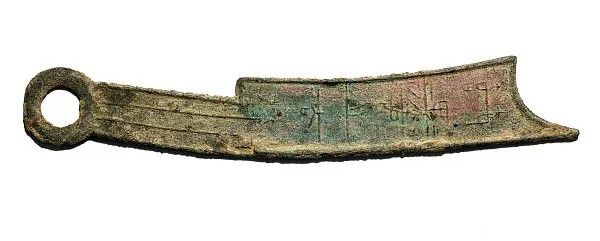
Image: Ancient Chinese bronze knife money with inscriptions.
Source: National Museum of American History
The Qin Reform and Birth of Cash Coins (221 BC)
Emperor Qin Shi Huang standardized currency into the ban liang, i.e. a round bronze coin with a square hole, eliminating regional varieties and establishing the format that would last two thousand years.
Dynastic Evolution of Cash Coins (Han – Qing)
Cash coins maintained their basic form across dynasties but evolved in inscription style, weight, and casting quality. Most display four-character legends read top-bottom-right-left, naming the reign era and denomination. Calligraphic styles varied: Han coins show simple characters, Tang pieces display elegance, Song issues feature refined execution, and Qing coins use bolder scripts. Provincial mints created subtle variations useful for attribution. In terms of availability, late Qing and Ming issues remain common, but certain early Han types and well-preserved Song specimens command significant premiums. Condition plays a major role in valuation, with collectors prioritizing crisp characters and natural patina over worn or corroded examples.
Imperial Silver and Gold (Late Qing – 1911)
As Western powers pressured China to modernize its currency, the Qing government introduced machine-struck silver coins in 1889. These pieces were Chinese coins with dragon designs featuring bilingual Chinese and Manchu legends, created to compete with foreign trade dollars circulating in Chinese ports. Provincial mints in Guangdong, Yunnan, and Sichuan produced distinctive varieties, some exceptionally rare due to limited mintages. Chinese gold coins existed in smaller quantities, primarily for diplomatic presentation. These late imperial issues bridged traditional cast bronze and modern Western minting technology.
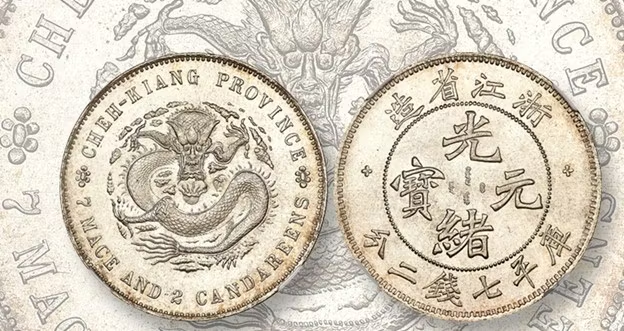
Image: Late Qing Dynasty silver dragon dollar from Chekiang Province.
Source: Coin World
Modern Era: Republican Chinese silver coins to Contemporary Bullion
Republican Era (1912 – 1949)
The fall of the Qing Dynasty ended imperial coinage but not silver production. The new Republic continued minting silver dollars using Western technology, introducing portraits of political leaders like Yuan Shikai and Sun Yat-sen. These coins, including the “Fat Man” dollar (Yuan Shikai) and various Sun Yat-sen types, featured Western-influenced designs with Latin legends alongside Chinese inscriptions, marking a decisive break from Chinese coins with dragon imagery. Provincial mints produced their own varieties, and certain early issues with low mintages or die variations are highly collectible today. Silver circulation declined sharply after the mid-1930s, following the U.S. Silver Purchase Act of 1934, which drained China’s silver reserves, and the outbreak of the Second Sino-Japanese War in 1937, which further disrupted production and trade.
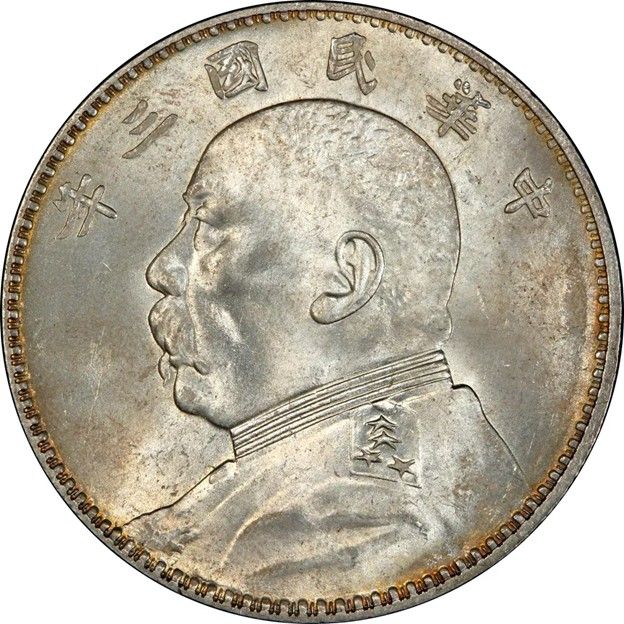
Image: Republic of China silver dollar with Yuan Shikai portrait.
Alt text: Chinese Republic “Fat Man dollar” from 1914-1921 showing Yuan Shikai left-facing portrait with Chinese characters and reeded edge, .890 silver.
Source: Numista
People’s Republic and Early Communist Era (1949 – 1980)
After 1949, the new government replaced precious metal coins with aluminum, copper-nickel, and brass issues. Designs emphasized socialist themes, such as workers, agriculture and industrial imagery, reflecting state ideology. Chinese commemorative coins in silver and copper-nickel celebrated political milestones like founding anniversaries and often celebrated revolutionary milestones. Most early People’s Republic circulation coins carry modest collector value, significant primarily as markers of China’s transition from precious metals to symbolic state coinage.
Reform and Bullion Revival (1980s – Present)
Economic liberalization in the 1980s reopened precious metal minting. China launched its Gold and Silver Panda series in 1982 and 1983 respectively, featuring .999 fine purity and annually changing panda designs, a departure from static Western bullion. Issued in multiple weights, Pandas merged national symbolism with modern engraving techniques, continuing China’s tradition of artistic coinage. Early issues from 1983 to 1985 – and particularly small-date and proof varieties – command strong premiums due to lower mintages. Counterfeits remain a persistent problem and collectors must verify authenticity through precise weight, diameter, and edge reeding.

Image: Modern Chinese Silver Panda bullion coin with bamboo background.
Source: Blanchard
Commemorative and Thematic Programs (1990s – Present)
Beyond Pandas, China produces limited-mintage gold commemoratives for historical events and anniversaries. The Lunar series, which consists of annual gold and silver coins honoring Chinese zodiac animals, has gained international popularity for its artistry and cultural resonance. Occasional bimetallic and platinum issues diversify the modern program. Chinese modern bullion, especially Pandas and early Chinese commemorative coins, typically carries higher numismatic premiums than generic bullion due to design changes and sustained collector demand.
Starting a Chinese Coin Collection in the Modern Era
The past two decades have transformed Chinese numismatics from a niche specialty into a major collecting category recognized in global auctions and investment portfolios. For new collectors, this modern era offers unprecedented access to both ancient Chinese coins and contemporary ones. Online resources, certification services, and active global markets make it possible to build a focused collection – whether centered on ancient cash coins, imperial silver, or modern Pandas – with greater confidence and accessibility than ever before
Global Market Growth
Chinese coins, particularly Silver Pandas and Lunar series issues, have gained strong traction among Western collectors over the past two decades. Rising awareness of Chinese culture, renewed interest in precious metals, and the aesthetic appeal of annually changing designs have driven sustained demand. Major Western auction houses now feature Chinese material regularly, and specialized dealer networks have emerged to serve this growing market.
Digital Authentication and Grading Standards
Technology has significantly improved verification and grading methods. Smartphone tools assist in comparing coins to reference images, while portable XRF analyzers verify metal composition on-site. Third-party grading services such as PCGS and NGC, both operating China-specific divisions, certify Chinese coins to international standards. Encapsulated (“slabbed”) examples often command premiums over raw pieces, especially for high-value issues where counterfeiting risk is greatest.
Buying and Selling Online
Chinese coins for sale are widely available through online platforms, but caution remains essential. Reputable dealers with clear return policies and authenticity guarantees provide the safest buying environment. Major auction platforms offer access to rare Chinese coins, though seller credentials should always be verified. Direct purchases from Chinese consumer sites carry higher risk: counterfeits are prevalent and buyer recourse limited. For selling, established dealers and auctions provide liquidity.
Roll Hunting and Circulation Finds
Outside China, discovering Chinese coins in circulation is uncommon but occasionally possible in areas with large Chinese communities. Most circulation finds are base-metal issues of modest value.
Identification and Authentication Guide
Authenticating Chinese coins requires understanding both historical production methods and modern counterfeiting techniques. The prevalence of high-quality fakes makes verification skills essential for any serious collector.
Character Recognition
Learning basic Chinese numerals and common reign marks forms the foundation of identification. Most cash coins display four characters read top-bottom-right-left, typically showing the emperor’s era name followed by tongbao (circulating treasure) or zhongbao (heavy treasure). Familiarizing yourself with frequently encountered dynasties, particularly Ming and Qing, allows quick preliminary assessment. Modern coins use simplified Chinese characters and Arabic numerals for dates and denominations.
Weight Standards
Authentic coins conform to specific weight ranges for their type and era. Cash coins varied by dynasty, but consistency within a series indicates genuineness. For early bronze issues, minor variation (often a few tenths of a gram) is normal, as exact uniformity was not achieved until machine striking. Modern Pandas and commemoratives must match published specifications exactly and even slight deviations suggest counterfeits.
Metal Composition
Testing silver and gold content verifies precious metal coins. Non-destructive methods include specific gravity tests, which compare weight-to-volume ratios against known standards. XRF analyzers provide precise composition readings without damaging coins. For old Chinese coins, particularly bronze pieces, patina color and texture offer clues: genuine bronze develops characteristic blue-green or brown oxidation.
Die Characteristics
Genuine Chinese coins show detail consistent with their minting method. Cast pieces exhibit subtle casting seams and granular texture, while struck coins display sharp rims and uniform fields. Counterfeits often reveal mismatched character styles, imprecise lettering, or incorrect edge patterns. Red flags include unusually low prices, artificial toning, and soft or uneven details inconsistent with authentic production.
Investment Perspective: Chinese Coins in 2025
Chinese coins occupy a unique position in the precious metals market, merging intrinsic metal value with numismatic rarity and deep cultural symbolism.
Advantages
Cultural Appeal
A growing Chinese and international collector base drives sustained demand, particularly for Pandas and Lunar series coins whose themes resonate across cultures. This interest is rooted in long-standing cultural attitudes toward gold as a store of wealth and a symbol of prosperity – values especially strong in China and India, which together account for nearly half of global gold demand. In both societies, gold plays a central role in savings, gifting, and intergenerational transfer. These traditions help explain why Chinese coins, especially gold and silver Pandas, maintain strong premiums even when global bullion prices soften.
Silver and Gold Content
Pandas offer precious-metal security yet command premiums over generic bullion due to annual design changes and limited mintages. For collectors evaluating silver investment options that include Chinese coins alongside other bullion products, Blanchard’s investment-grade silver selection provides a range of choices suited to different portfolio strategies.
Historical Significance
Ancient Chinese coins and imperial specimens, often bronze or silver, offer tangible connections to Chinese history, attracting collectors beyond traditional bullion investors.
Artistic Merit
The artistry of Chinese coinage attracts buyers who might not otherwise collect coins, broadening the market.
Limited Production
Annual design turnover creates natural scarcity, as each year’s Panda becomes a distinct collectible once the next design releases.
Considerations
Authenticity Concerns
High-quality counterfeits require expert verification or third-party grading before purchase.
Cultural Knowledge
Understanding Chinese history enhances collecting success, making Chinese coins more demanding than Western issues.
Import/Export Regulations
For ancient Chinese coins, regulations vary by jurisdiction and can complicate international transactions, particularly for items classified as cultural property. Exporting old Chinese coins itself is generally prohibited, and buyers should verify provenance and import requirements before making cross-border purchases.
Conclusion
Chinese coinage spans over two millennia of monetary evolution, from ancient cast bronze to modern struck bullion. For Western collectors, these coins offer a compelling combination of historical depth, artistic tradition, and investment potential that few other world coin series can match. The growing accessibility of authentication services, international grading standards, and specialized dealers has made building a Chinese collection more feasible than ever. Explore Blanchard’s Chinese Mint selection to begin or expand your collection with confidence.
FAQs
1. How much are Chinese coins worth?
Chinese coins’ value ranges from a few dollars for common late Qing cash coins to substantial sums for rare imperial silver or early-date Pandas. Condition, rarity, and authenticity determine price more than age alone.
2. Why do Chinese coins have holes?
The square hole allowed coins to be strung together on cords for counting, transport, and storage, a practical solution that became a defining feature of Chinese currency for over two thousand years.
3. How to identify ancient Chinese coins?
Read the four-character inscription top-bottom-right-left to determine the reign era and denomination, then compare calligraphic style, weight, and casting characteristics against reference materials for the suspected dynasty.
4. How to spot fake Chinese coins?
Check weight precision, examine character clarity and style consistency, look for incorrect casting seams or artificial patina on ancient Chinese coins, and verify edge reeding and specifications on modern issues. When in doubt, use third-party grading services.
Gold Tops $4,000 Then Retreats After Fed’s Mixed Signals on Future Cuts
Posted on — Leave a commentFed Cuts Interest Rate in Data Drought
Just like a pilot flying a plane through a blizzard in white-out conditions, the Federal Reserve is making interest rate decisions blindfolded. Fed officials lack fresh economic data, because of the government shutdown. Today, amid the data drought, Fed officials voted 10-2 to cut its official interest rate to 3.75% – 4%. The Fed also said it will stop shrinking its balance sheet on December 1.
official interest rate to 3.75% – 4%. The Fed also said it will stop shrinking its balance sheet on December 1.
Fed policymakers said that “job gains have slowed” and “risks to employment rose in recent months” and the rate cut was intended to help ease the weakness in the labor market, the second cut this year.
Gold Market Reacts
Gold edged slightly higher poking back above $4,000 initially on the news but then drifted back below that level after Federal Reserve Chairman Jerome Powell put future rate cuts into question.
“A further reduction in the policy rate at the December meeting is not a foregone conclusion–far from it,” Powell said. “Policy is not on a pre-set course.”
The comments surprised Wall Street, which had been banking on another rate cut this year. Treasury yields climbed and the stock market wiped out its gains after the Fed Chair’s comment.
Bigger Picture
Gold has retreated in recent days as a corrective pullback took hold following the record-high move above $4,370 mid-month. Short-term momentum traders took profits on the double-digit gains seen in precious metals this year. However, buyers entered the market and bought the dip in gold prices, and the long-term uptrend remains intact.
Even after the recent pullback, gold remains up over 50% this year, supported by central bank buying and safe haven buying as investors seek to protect their wealth amid runaway budget deficits.
Dissent Grows at the Fed
Not all voting members of the Federal Open Market Committee agreed on today’s rate cut. New Fed governor Stephan Miran was against the quarter point drop, saying he believed the central bank should lower rates faster with a half percentage point cut.
On the opposite side, Kansas City Fed President Jeffrey Schmid voted against today’s rate cut saying he thought the central bank should hold steady on rates. Dissent is growing at the Fed, which is unusual after many years of voting committee members acting in unison.
Why the Discord at the Fed?
Inflation remains stubbornly high and sits above the Fed’s 2% target rate. Fed officials conceded today that inflation “has moved up since earlier this year and remains somewhat elevated.”
When the Fed cuts rates, that typically creates easier money conditions, which can make inflation worse. The Fed had to decide should it keep rates steady to fight inflation or should it lower rates to try to help the weakening job market.
“There is no risk-free path for policy as we navigate this tension between our employment and inflation goals,” Fed Chair Powell said today.
Powell called today’s rate cut a risk-management type of move to bring monetary policy closer to a neutral stance.
What’s Next for the Fed?
Fed officials appear divided on the path forward for future rate cuts, especially since inflation is running above the Fed’s 2% target. Financial markets had nearly priced in another rate cut in December. Today’s Fed meeting creates uncertainty about the path going forward.
Today’s Gold Price Offers You Opportunity
This week, at the London Bullion Market Association’s precious metals conference in Kyoto, the outlook for gold remains upbeat, with a survey of 106 attendees projecting that gold will be trading at nearly $5,000 an ounce a year from now.
Gold’s role as a portfolio hedge remains strong. Short-term consolidation could unfold in the market following the breathtaking gains achieved this year, which create opportunities for long-term investors to step in and buy more gold with your dollars today. As investors have known for centuries, gold’s strength lies in protecting and growing your wealth, despite inflation, economic uncertainty and stock market volatility. Act now to lock in more insurance for your wealth with a greater allocation to gold.
“Holiness to the Lord”: The Story Behind the 1849 $2.50 Mormon Gold Coin
Posted on — Leave a commentA coin born of dust, distance, and scarcity
In the late summer of 1849, the Great Salt Lake Valley was hungry for a medium of exchange that wasn’t barked bargains or paper promissories. Mormon Battalion veterans and prospectors had brought home glitter from California, merchants and tithing offices had bins of raw dust, but not much coined money. So church leaders set up a tiny mint in an adobe building on South Temple Street, part of it a dentist’s office, where John Kay and others began turning frontier dust into frontier dollars. The shop’s early output included the small but mighty $2.50 piece, practical for daily trade and stamped with a message the community carried in its bones: “Holiness to the Lord.”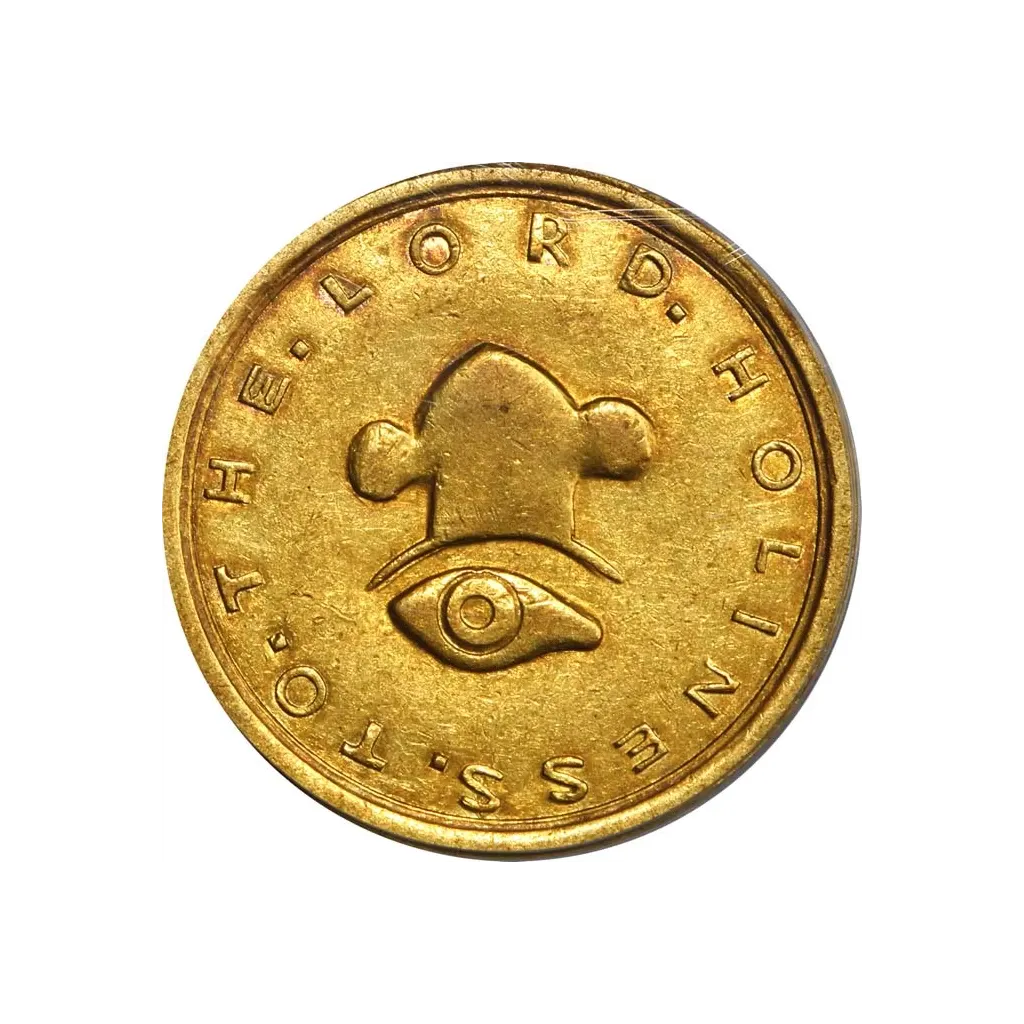
What the 1849 $2.50 Mormon Gold Coin looked like and why
The 1849 Mormon $2.50 (often cataloged as Kagin-1) carried unmistakable symbolism. The obverse paired a Phrygian cap and the all-seeing eye with the “Holiness to the Lord” legend, linking liberty to devotion. The reverse showed clasped hands for fellowship, the date and denomination, and an abbreviated mint signature: “G.S.L.C. P.G.” (Great Salt Lake City, Pure Gold). The small denomination suited daily purchases in a cash-poor settlement, and contemporary accounts suggest the $2.50s and $5s were the real workhorses of circulation.
The mint that fit inside a dentist’s office
Coining resumed in September 1849 after a hiatus for supplies. Dies for $2.50, $5, and $20 were prepared, and the team coined chiefly lower denominations for local trade. Early pieces were struck from largely unrefined California placer gold. Soon a small addition of silver was mixed in to harden the coins. All this happened in a space so modest that later writers simply called it the “Deseret Mint,” a frontier solution for a frontier economy.
The controversy: were Mormon gold coins “debased”?
As the coins traveled east to pay for goods, they ran into assays and criticism. In January 1850, the New Orleans Mint’s assayer, William P. Hort, tested a $20 piece and found it both underweight (by about 85 grains, roughly 20%) and slightly below U.S. fineness. Soon after, the Philadelphia Evening Bulletin warned readers, and assayers Jacob Eckfeldt and William DuBois published detailed figures: average fineness near .899 (a later supplement averaged .866), with the $2.50 valued around $2.25 at melt. Beyond the lab, traders discounted Mormon coins 10–25%. Most historians read this not as fraud but as frontier practice, marked by scarce acids, improvised tools, and a team learning assaying on the fly.
Context, not condemnation
Utah historical sources note that the mint first struck coins without alloy and later added a bit of silver to strengthen them, consistent with a shop iterating under pressure. Within the community, the coins circulated at par and, practically speaking, kept the economy moving when distance and scarcity were the real adversaries.
Why the 1849 $2.50 endures
Few survived. Most were melted once they left the valley or later when federal coin dominated commerce. That scarcity, and the story they carry, helps explain why high-grade pieces bring strong prices today. More than artifacts, these quarter eagles are condensed history: belief, migration, necessity, and the hard lessons of making money, literally, on the edge of the American map.
FAQ About the 1849 $2.50 Mormon Gold Coin
What is the 1849 $2.50 Mormon gold coin? It is a privately minted gold quarter eagle produced by Mormon settlers in Great Salt Lake City in 1849. It bears the inscriptions “Holiness to the Lord” and “G.S.L.C. P.G.” and was struck from California gold dust refined locally.
Why did the Mormons mint their own gold coins? When settlers arrived in Utah, there was virtually no U.S. coinage in circulation. The church’s mint allowed local trade to function using gold from returning Battalion members and California miners.
What caused the controversy about debasement? Assays performed in 1850 found the coins to be underweight and slightly below U.S. fineness standards. The shortfall resulted mainly from primitive refining and assay tools, not deliberate fraud.
Were the Mormon gold coins accepted outside Utah? Only with difficulty. Traders often discounted them by 10–25% outside Utah Territory. Within Mormon settlements, however, they circulated freely at full face value.
How rare is the 1849 $2.50 coin today? Extremely rare. Most were melted or heavily worn in circulation. Surviving examples are prized by collectors and can sell for substantial sums depending on condition and provenance.
What does “G.S.L.C. P.G.” mean? It stands for “Great Salt Lake City, Pure Gold,” identifying both the place of origin and the intended quality of the metal.
Gold Climbs as CPI Inflation Opens Door for Fed Rate Cut
Posted on — Leave a commentGold climbed on the release of the September Consumer Price Index data, which came in a tad cooler than expected. Headline inflation increased 3% from a year ago, which is slightly below Wall Street’s expectations for a 3.1% jump. 
Wall Street interpreted the inflation data as a green light to a Federal Reserve interest rate cut at the Oct. 28-29 meeting. Wall Street traders are pricing in 97% odds of a 0.25 percent rate cut to 3.75-4.00% at the next Fed meeting, according to the CME FedWatch tool, which is bullish for gold.
Investors Buy Gold Dip After CPI Report
Gold advanced on the inflation news, climbing to $4,125.80 an ounce. After hitting a record high at $4,373 mid-month, gold pulled back slightly as short-term traders took profits. But the dip didn’t last long, and gold quickly rebounded after the CPI data. Gold’s ability to hold above the $4,000 level on the modest pullback reveals that the long-term, historic uptrend remains intact.
Minor pullbacks and corrections are normal events during long-term uptrends and gold is still up about 55% this year—cementing its status as one of 2025’s best performing asset classes.
Inflation Still Above Fed’s 2% Target Rate
While Wall Street traders saw the CPI number as a reason the Fed would go ahead with a rate cut, stubborn inflation remains well above the Fed’s target rate at 2%. Easing the Fed’s benchmark interest rate has the potential to make inflation worse—not better—which will help keep the uptrend in gold intact in the year ahead.
Why Did This Report Get Released?
Despite the government shutdown, the Bureau of Labor Statistics called back workers to help prepare the CPI report for release this month. By law, the government needs the CPI report to calculate the annual cost-of-living-adjustment for Social Security recipients. So, this CPI report is one of the few pieces of government information available during the shutdown. The government has already warned that the October CPI report is unlikely to be released on time.
Fed Rate Cut Cycles Are Positive for Gold
Looking ahead, Fed rate cut cycles are historically positive events for gold, because lowering rates reduces the opportunity cost of holding a non-yielding asset like precious metals. Rate cut cycles also boost inflation expectations and weaken the U.S. dollar—both which are also positive factors for gold.
|
Period |
Why the Fed Cut Rates |
Gold Price Increase |
|
2000-2003 |
Dot-com stock market crash, recession worries |
+43% |
|
2007-2008 |
Global Financial crisis response |
+54% |
|
2019-2021 |
Global slowdown, COVID-19 pandemic |
+26% |
Consumer Sentiment Sagged to a 5-Month Low
The University of Michigan’s October sentiment index reveals consumer confidence fell 1.5% on a monthly basis to 53.6% from September’s 55.1 reading. Notably, American’s confidence in the economy is falling, while their long-run inflation expectations are rising. American consumers expect prices to rise 3.9% over the next five to ten years, higher levels than they expected last month.
Record Breaking Rally in Gold Set to Continue Into 2026
Despite the recent modest pullback in gold, analysts believe this rally in gold can’t be stopped.
“Investors are watching gold not just as a hedge against inflation, but as a barometer for everything from central bank policy to geopolitical risk,” Morgan Stanley Metals & Mining Commodity Strategist Amy Gower said in a Oct. 22 research note. “We see further upside in gold, driven by a falling U.S. dollar, continued central bank purchases and a backdrop of uncertainty supporting demand for this safe-haven asset.”
Goldman Sachs recently bumped up their 2026 price forecast to $4,900 an ounce. Bank of America sees potential for gold to climb to $5,000 an ounce. Yardeni Research also expects gold to hit $5,000 in 2026 with the potential for it to climb to $10,000 by the end of the decade, which would mark a 146% rally over the next five years.
Why Holding Real Gold Beats Gold ETFs
Posted on — Leave a comment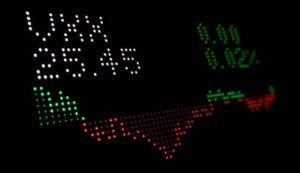
Gold has long been viewed as a store of value, a hedge against inflation or currency devaluation, and a safe-haven asset when things get crazy. Today, investors have more options than ever to gain exposure to gold, but not all are created equal. One of the perennial debates is: physical gold vs. gold ETFs. Below, we explore why many investors favor holding real gold rather than paper substitutes.
1) True Ownership & No Counterparty Risk
When you own physical gold (bars, coins, bullion), you possess the metal itself—you can hold it, see it, weigh it, and store it wherever you choose. That direct ownership means there is no intermediary between you and your metals.
By contrast, a gold ETF is a financial vehicle, similar to stocks, that holds gold (or gold derivatives) on behalf of investors. While many ETFs are physically backed, your claim is a share in that fund, not the metal itself. That introduces counterparty risk: in extreme scenarios (custodian default, fraud, regulatory changes), your exposure is to the fund structure, not the metal directly.
Because physical gold is an asset you literally can hold in your hand, it cannot vanish with the collapse of a fund. The principal risks lie in storage, theft, or mismanagement and not in a fund’s solvency.
2) No Ongoing Management Fees Eating Into Your Gains
Gold ETFs charge annual expense ratios, fees to cover storage, auditing, administration, and fund management. Over time, that fee eats away at your returns. Even a modest 0.2%–0.4% per year can compound meaningfully over decades.
By contrast, owning physical gold has no built-in annual “management” fee. Your costs are upfront (premium over spot, storage, insurance) and periodic (vault fees, security), but not a percentage deducted year after year. Particularly for long-term holdings, avoiding recurring fees can improve net performance.
3) Independence from Fund Tracking & “Tracking Error”
A well-run gold ETF aims to mirror the spot price of gold. But in practice, ETFs can suffer from tracking error—the fund’s performance deviating from gold itself due to administrative costs, transaction costs, rebalancing, or imperfect hedging. Over time, those small divergences can create a drag.
Since physical gold is the underlying asset itself, you bypass that layer of abstraction and the risk of mismatch. You aren’t depending on a fund’s ability to perfectly track gold; you hold what you want directly.
4) Tangibility & Psychological Confidence
Money isn’t just numbers. It’s trust. For many investors, there’s psychological comfort in physically moderating an asset. Having a bar or coin in your possession provides a visceral and reassuring sense of control that paper claims lack. This emotional and mental factor can’t be ignored, especially for investors who value certainty.
5) Flexible Use & Private Transferability
Physical gold can be transferred privately, gifted, or used as collateral (depending on where you live). You have flexibility in how it changes hands. You could, for instance, deliver gold to someone directly without needing to liquidate something.
You can also store your gold wherever you like. In a home safe, private vault, or bank safe deposit box. That gives you control over jurisdiction, security protocols, and access.
When done the right way…buying recognized bullion, choosing safe storage, and dealing with Blanchard…the net advantages often outweigh these drawbacks for many serious investors.
Conclusion
If your objective is long-term preservation, real ownership, and minimizing structural and counterparty risk, physical gold has a strong case.
Holding the real metal means no dependency on fund structures, no ongoing management fees, no tracking error, and a tangible, portable asset you control entirely. For those who see gold as more than just a ticker symbol and as a foundation for financial security, owning physical gold wins the argument.
At Blanchard, we believe tangible precious metals offer a level of diversification and portfolio control that paper substitutes can’t match. Whether you’re a seasoned buyer or just getting started, reach out to us for guidance. We’ve been in business for over fifty years, and that counts for something: Trust.
Barber Quarter Key Dates: The 1901-S and Other Scarce Dates Every Collector Should Know
Posted on — Leave a commentIf there were a king of American quarter collecting, it would be the 1901-S Barber Quarter. With only 72,664 ever minted and fewer than 500 surviving today across all grades, this coin represents the pinnacle of rarity. Yet the 1901-S is only one example of the dramatic scarcity found within the Barber series. While many dates trade close to their silver melt value, others are coveted key issues that can soar to five-figure prices.
This guide examines the scarcest Barber quarter dates, their distinctive characteristics, and the historical factors that created these numismatic treasures.
What Makes Barber Quarters Special?
Four key factors separate Barber quarters from other series and directly impact their collectability and value: Barber’s distinctive design legacy, substantial silver content, the 25-year production span from the 1892 Barber quarter through 1916, and critical mint mark placement.
Barber’s Design Legacy
Charles E. Barber served as Chief Engraver of the United States Mint from 1879 to 1917, and ranks among the most influential coin designers in American history. In 1892, his Liberty Head design replaced the long-running Seated Liberty motif on dimes, quarters, and half dollars.

Image: Profile portrait of Charles E. Barber in formal attire, showing the distinguished Chief Engraver in his later years.
Source: Coin Collecting
The Barber quarter features Liberty’s right-facing profile wearing a Phrygian cap adorned with stars and a laurel wreath. This classical imagery symbolized freedom and victory, reflecting America’s growing confidence as it entered the modern industrial era. The reverse displays a heraldic eagle with outstretched wings, clutching arrows and an olive branch.
What made Barber’s work revolutionary was its unprecedented design unity: the same Liberty portrait appeared across three silver denominations simultaneously, creating visual consistency in American coinage that had never existed before. This standardization embodied the institutional stability America sought during rapid industrial expansion from 1892 to 1916. The clean, dignified classical approach marked a deliberate shift away from the more ornate Seated Liberty design, signaling changing aesthetic preferences as the nation modernized.
Silver Composition
Every Barber quarter contains exactly 0.1808 troy ounces of pure silver, thanks to the 90% silver, 10% copper composition mandated by the Coinage Act of 1873. This substantial precious metal content provides fundamental value protection that later base metal coins lack. Even the most common dates cannot fall below their Barber quarter melt value, creating a floor that rises and falls with precious metal markets. This intrinsic worth has proven particularly valuable during periods of high silver prices, when worn common dates often sell for more than their collector premium alone would justify.
Watch this video to learn how to grade Barber quarters and identify the condition factors that separate silver-value coins from valuable collectibles.
25-Year Series Span
The quarter-century production run created remarkable collecting diversity against the backdrop of America’s transformation from the Gilded Age through the Progressive Era. This extended timeframe allowed for significant Barber quarter mintage variations, from the massive 1899 Philadelphia issue of over 12 million coins to the tiny 1913-S run of just 40,000 pieces. Different economic conditions throughout the series influenced both original mintages and subsequent survival rates, creating the rarity patterns collectors navigate today. The series’ connection to the Gilded Age makes these coins tangible links to one of America’s most economically vibrant periods.
Mint Mark Significance
Barber quarters were struck at four mints: Philadelphia (no mark), San Francisco (“S”), New Orleans (“O”), and Denver (“D,” final years only). While the mark always appears beneath the eagle’s tail, its real importance is in the value spread it creates. The same date can be nearly worthless from Philadelphia yet a five-figure rarity from San Francisco, as with the 1901 issue. New Orleans coins often show weaker strikes, and Denver produced some of the lowest late-series mintages. For collectors, mint marks define rarity more than any other factor.
The 1901-S: King of Barber Quarters
As the rarest in the series, the 1901-S Barber Quarter is defined by its low mintage, limited survival, and intense collector demand.

Image: Both sides of a 1901 Barber quarter showing Liberty’s profile and the heraldic eagle with attractive rim toning.
Source: PCGS
Rarity Facts and Survival Rates
The 1901-S posted one of the lowest mintages in the Barber quarter series at just 72,664 pieces. To put this in perspective, the common 1899 Philadelphia issue produced over 12 million coins, i.e. nearly 175 times more. Although the 1913-S had an even smaller mintage of 40,000, more examples were saved at the time, leaving the 1901-S Barber Quarter far scarcer in surviving numbers. Today fewer than 500 examples are known across all grades, with most showing heavy wear from circulation. The vast majority grade Very Good to Fine, as few collectors recognized its rarity when new. High-grade pieces above Extremely Fine are exponentially scarcer, and Choice Uncirculated coins rank among the greatest prizes in all of American numismatics.
Value and Grade Sensitivity
The 1901-S Barber Quarter demonstrates how extreme rarity translates into sustained value growth over decades. Early collectors in the 1960s could acquire decent examples for only a few hundred dollars, as the coin’s significance wasn’t widely recognized. Today, even heavily worn specimens command four-figure prices, while high-grade pieces routinely achieve five-figure results at auction. Condition plays an outsized role in these valuations: the jump from mid-grade to Extremely Fine can mean many thousands of dollars, and true Uncirculated examples represent exponential premiums. This sharp grade sensitivity underscores the 1901-S’s reputation as the ultimate prize of the Barber quarter series.
Complete Barber Quarter Key Dates Breakdown
The Barber quarter series includes several other significant rarities beyond the 1901-S. These dates present collecting challenges due to low mintages, poor survival rates in higher grades, or distinctive strike characteristics that affect their availability and value.
The Other Big Keys
1913-S Barber Quarter
Struck to a mintage of just 40,000, this is technically the lowest-mintage Barber quarter. While more survive than the 1901-S, most are in heavily worn grades, and problem-free higher-grade coins are elusive. Collectors prize it as both a key rarity and the last great challenge near the end of the series.

Image: Both sides of a 1913-S Barber quarter showing the lowest mintage regular strike in the series with clear S mint mark.
Source: PCGS
1896-S Barber Quarter
With 188,039 minted, the 1896-S does not have the smallest numbers, yet its survival pattern makes it brutally rare in all but the lowest grades. Most pieces entered circulation in San Francisco’s booming economy and stayed there, leaving virtually no Mint State survivors. This combination of relatively “normal” Barber quarter mintage but extreme grade rarity gives it a status nearly equal to the 1913-S. Even problem-free examples in circulated grades command substantial premiums, as shown by this Blanchard example of a certified VF25 specimen.

Image: Both sides of an 1896-S Barber quarter demonstrating one of the “Big Three” key dates with the San Francisco mint mark clearly visible.
Source: PCGS
Semi-Key Dates
1892-S Barber Quarter
The debut San Francisco issue had 964,079 struck, but few were set aside. Heavy regional circulation means attractive examples above VF are genuinely scarce.
1893-S Barber Quarter
Though over 1.4 million were minted, this date enjoys strong collector demand as an early San Francisco rarity. Mid-grade examples are collectible, but finding pieces with sharp strikes and good surfaces is a consistent challenge.
1909-S Barber Quarter
With 1,348,000 struck, this is more available than the big keys but still difficult in higher grades. Most circulated hard, and choice survivors are limited.
1914-S Barber Quarter
With just 264,000 struck, the 1914-S ranks among the lowest-mintage late issues. While not the last San Francisco quarter, it remains a semi-key whose scarcity is felt most acutely in higher grades.
Branch Mint Challenges
1896-O Barber Quarter
The New Orleans Mint struck 1.5 million quarters in 1896, leaving the date plentiful in circulated grades. However, the mint’s limited resources and reliance on overused dies produced coins with consistently weak strikes and soft details. Even uncirculated pieces often lack sharp definition, making the few well-struck survivors genuinely scarce and highly desirable to collectors.

Image: Both sides of an 1896-O Barber quarter showing the New Orleans mint mark and typical strike characteristics from that facility.
Source: PCGS
1901-O Barber Quarter
The New Orleans Mint produced just over 1.6 million quarters in 1901, a relatively modest mintage that leaves the date scarcer than many of its Philadelphia counterparts. Like the 1896-O, strike quality is the defining challenge: coins were often struck with worn dies, resulting in flat details on Liberty’s hair and the eagle’s breast. Circulated pieces are obtainable, but examples with sharp definition in AU or Mint State are elusive.

Image: Both sides of a 1901-O Barber quarter displaying the New Orleans mint characteristics and attractive rim toning.
Source: PCGS
Varieties
The Barber quarter series has relatively few dramatic varieties, but specialists recognize several worth noting. The best-known is the 1902 quarter with a misplaced “0”, where the digit appears partially on the rim. Other die varieties include repunched dates and mintmarks, most often on New Orleans issues, as well as occasional doubled-die obverses and reverses on early 1892 coins. For advanced collectors, such pieces add an extra layer of challenge beyond the familiar key and semi-key dates.
Modern Collecting Strategies
Today’s Barber quarter collectors employ various approaches depending on their budget, goals, and risk tolerance. Understanding these strategies helps newcomers choose a path that aligns with their collecting philosophy.
Silver Content Baseline
Every Barber quarter contains 0.1808 troy ounces of pure silver, creating a price floor that fluctuates with precious metal markets. Understanding Barber quarter value requires recognizing how silver content establishes the baseline, while numismatic premiums depend on rarity and condition. When silver prices rise, even heavily worn common dates gain value, while falling silver prices can compress premiums on moderately scarce issues.
Type Collecting
Many collectors approach the Barber quarter as a type coin, selecting a single high-grade example to represent the design in a broader U.S. type set. This method emphasizes condition rather than completeness, making it possible to acquire gem-quality common dates at a fraction of the cost of the keys. Philadelphia issues from 1892-1900 or 1910-1915 are especially favored for their strong strikes and relative availability. Later dates like the 1909 Barber quarter provide excellent examples of the mature design without key date premiums. For type collectors, a single MS-65 common date is usually enough to represent the series.
Date/Mint Collecting
Building complete sets remains the ultimate challenge, though many collectors modify this goal by focusing on specific eras or mint combinations. Some pursue only Philadelphia issues, avoiding branch mint premiums while still experiencing the series’ chronological progression. Others collect by decade, with 1892-1900 and 1910-1916 being most accessible. Common dates like the 1898 Barber quarter provide affordable building blocks for comprehensive collections.
Condition Collecting
This strategy involves assembling a representative set in uniform grade, typically VF-20 through AU-50. Condition collectors appreciate consistent quality across dates while avoiding the exponential premiums of uncirculated examples. This approach provides excellent educational value, as wear patterns and strike differences become apparent when comparing multiple examples in similar grades. VF-AU sets also tend to be more affordable and less volatile than chasing individual keys in Mint State, making this one of the most balanced and satisfying collecting methods.
Investment Perspective: Barber Quarters in 2025
From an investment standpoint, Barber quarters combine intrinsic silver value with long-established collector demand. Understanding current Barber quarter values requires recognizing both the precious metal baseline and the numismatic premiums that key dates command in today’s market.
Advantages
Silver Floor Protection
Every Barber quarter contains 0.1808 troy ounces of silver, providing a guaranteed melt-value baseline. This floor gives Barber quarters a safety net that base-metal series lack, offering downside protection during soft markets.
Established Market
Nearly sixty years since the last Barber quarter was minted has created a mature, transparent market. Values are shaped by decades of auction records and collector demand, not short-term speculation. This stability makes the series more predictable than modern commemoratives or bullion-driven issues.
Affordable Entry
Despite their history and scarcity, Barber quarters remain approachable compared to other classic series. Semi-key dates can still be acquired in collectible grades at modest prices, while even the great rarities command less than similarly scarce Morgans or early U.S. gold. This affordability makes the series attractive to both new collectors and seasoned investors diversifying holdings.
Completion Potential
With 74 issues in total, the Barber quarter set is demanding yet achievable. The presence of several keys ensures long-term demand, but the overall length of the series doesn’t overwhelm collectors the way Morgans or Lincolns can. This balance between challenge and attainability helps sustain liquidity across all dates and grades.
Considerations
Condition Sensitivity
Barber quarters are highly grade-sensitive, with sharp jumps in value as one moves from circulated to Mint State. A key date in VF may be affordable, but in MS it can command several multiples of the price. Professional authentication and grading become essential to protect investments and ensure liquidity in higher-value coins. Understanding proper coin grading standards helps collectors make informed purchasing decisions and avoid costly mistakes.
Storage Requirements
Silver surfaces are prone to environmental damage, and improper storage can dull luster or create unattractive toning. While original patina can enhance value, harsh or uneven retoning often reduces marketability. Secure, climate-controlled storage helps preserve both numismatic premiums and silver content.
Conclusion
Barber quarters combine history, silver value, and authentic rarity in a way few U.S. coin series can match. Key dates stand out for their low mintages and limited survival, while common issues provide an accessible entry point backed by 90% silver content. Over a century of collector demand has kept the series both stable and relevant, whether pursued as a single type coin or as part of a complete set. For those ready to add Barber quarters or other rare pre-1933 U.S. coinage to their holdings, Blanchard offers authenticated examples and expert guidance..
FAQs
1. What is a Barber quarter?
A Barber quarter is a silver quarter dollar designed by Chief Engraver Charles E. Barber and minted from 1892 to 1916. These coins feature Liberty’s profile on the obverse and a heraldic eagle on the reverse.
2. How much is a Barber quarter worth?
Barber quarter value depends on three key factors: date, mint mark, and condition. Values range from silver melt value for common worn dates to thousands of dollars for key dates and high-grade examples.
3. Where is the mint mark on a Barber quarter?
The mint mark appears on the reverse beneath the eagle’s tail feathers, just above the space between “QUARTER” and “DOLLAR.”
4. How much silver is in a Barber quarter?
Each Barber quarter contains 90% silver and 10% copper.
How Gold Spot Prices Work: Market Mechanisms, Players & Data Sources
Posted on — Leave a commentLook up the gold price on three different websites and you’ll likely see slightly different figures. Unlike stocks with a single exchange price, gold trades continuously across global markets through a network of banks, exchanges, and data providers. Each site is quoting the spot price, i.e. the current market value of gold for immediate delivery, though small variations appear because different platforms pull data from different sources. This article explains how gold spot price actually works, who sets it, and why understanding these mechanisms helps investors make smarter decisions.
Watch this educational video for additional context on the key market forces that drive gold price movements.
What Does “Gold Spot Price” Actually Mean?
The term “spot price” sounds straightforward, but in gold it comes with technical complexities that don’t exist in most other markets.
The Technical Definition
The gold spot price is the current market price for one troy ounce of gold, quoted for immediate settlement. In this context, “spot” refers to a purchase intended for immediate delivery, as opposed to a futures contract for delivery at a later date. In practice, “immediate” means settlement within two business days (T+2), which is the standard time required for payment to clear and ownership to transfer.

Image: Gold spot prices are quoted per troy ounce, with bars like this 999.9 fine gold serving as the benchmark.
Source: Blanchard
Theory vs. Reality in Physical Markets
Spot transactions by definition require immediate delivery, but physical gold markets operate differently than this theoretical framework suggests. Several practical factors typically complicate true spot pricing in physical transactions. Physical dealers usually must source inventory, verify authenticity, arrange secure transport, and process documentation – activities that often extend beyond the two-day settlement window. Large institutional buyers face similar constraints when purchasing physical metal rather than paper contracts, frequently requiring extended settlement periods for vault storage and chain-of-custody procedures. These logistical realities mean that most quoted spot prices reflect paper gold markets where transactions happen electronically, though some dealers with sufficient inventory and infrastructure can accommodate genuine spot transactions.
The Benchmark Standards
Spot gold price quotes require precise specifications to ensure consistency across global markets. Two primary benchmarks define gold pricing: on COMEX, futures contracts are based on 100-ounce bars of .995 fine gold, while the London Bullion Market Association (LBMA) uses Good Delivery bars weighing 350-430 ounces at a minimum of .995 purity. These shared standards allow traders and institutions worldwide to reference the same underlying product when discussing the gold spot price, whether the trade settles physically or through paper contracts.
Dollar-Denominated Pricing
Global gold spot pricing is universally quoted in U.S. dollars, making the dollar the reference point for gold’s value worldwide. In financial markets, this appears as the XAU/USD pair, where XAU represents one troy ounce of gold (from the Latin aurum) and USD represents U.S. dollars. While gold can be purchased in local currencies across the globe, all fundamental pricing originates in dollars. As a result, shifts in dollar strength have immediate effects on gold prices everywhere, even when buyers and sellers never handle U.S. currency directly. This dollar-centric system ensures that whether you’re buying gold in London, Shanghai, or New York, the core value calculation always traces back to the same USD-denominated spot price of gold.
Who Sets the Gold Spot Price?
Unlike markets with a single exchange price, the spot price of gold is shaped collectively by many institutions trading around the world.
Primary Gold Pricing Hubs
The London Bullion Market Association (LBMA) operates the world’s largest over-the-counter gold market. Twice daily at 10:30 AM and 3:00 PM London time, the LBMA conducts electronic auctions among major bullion banks to establish the official “LBMA Gold Price.” This price serves as a global benchmark that replaced the century-old “London Fix”, i.e. a telephone-based process where five major banks negotiated a single gold price, in 2015.

Image: The LBMA headquarters, where twice-daily electronic auctions set global gold price benchmarks.
Source: LBMA
COMEX, part of the Chicago Mercantile Exchange Group, runs the world’s most active gold futures market in New York. These contracts represent agreements to buy or sell 100-ounce gold bars at future dates, but the massive trading volumes – often exceeding 200,000 contracts daily – create significant influence on the current spot gold price. Most COMEX contracts settle in cash rather than through physical delivery, making it primarily a paper gold market that shapes pricing worldwide.
Secondary Market Influences
Beyond the two primary hubs, other players directly shape XAU USD spot gold price. The Shanghai Gold Exchange drives significant movements during Asian trading sessions, particularly when Chinese demand surges or new contracts shift global supply calculations. Together, these sessions create a 24-hour pricing cycle in which trading passes from Asia to London to New York, with each region’s open sparking fresh activity that can move spot prices immediately.

Image: Gold trading follows the sun across global time zones, creating continuous price discovery.
Source: Investing Live
Liquidity and Data Providers
Day-to-day gold trading depends on bullion banks and market makers, who provide continuous buy and sell quotes that keep the market liquid. Their quotes feed into the spot market and help determine the XAUUSD spot gold price investors actually see. Data providers such as Reuters, Bloomberg, and other financial platforms then aggregate these inputs from across the globe, publishing real-time prices that become the reference point for dealers and investors.
Why Spot Gold Price Differs Across Platforms
Given that multiple data sources feed into spot pricing, variations between platforms are inevitable and highlight key differences in how companies handle pricing data.
Data Aggregation Methods
Different platforms prioritize different market sources when calculating their displayed price, creating the first layer of variation. Some platforms emphasize COMEX futures data from New York trading, while others weigh LBMA auction results from London more heavily. These source preferences can produce legitimate differences of several dollars per ounce.
Additionally, platform refresh rates vary significantly. Some update prices every few seconds to capture real-time movements, while others lag by minutes, creating temporary discrepancies that become pronounced during volatile trading periods when gold prices shift rapidly.
Currency conversion timing introduces yet another variable, since platforms may update XAU USD spot gold price rates at different points throughout the trading day.
This is why checking multiple sources often shows slightly different spot prices, even at the same moment.
Commercial Manipulation and Transparency
More concerning than technical variations are deliberate commercial adjustments, where some dealers inflate a displayed XAUUSD spot gold price to increase profit margins on physical sales. These manipulated feeds can show prices significantly above true market rates, misleading customers about actual gold values.
Reliable pricing requires direct access to unfiltered market data from primary sources rather than third-party aggregators who may introduce delays or modifications. Platforms using verified feeds from bullion banks and major exchanges provide more accurate pricing than those relying on secondary data sources or applying commercial markups.
Blanchard’s pricing reflects direct market feeds without commercial manipulation, ensuring customers see authentic spot prices rather than artificially inflated rates designed to boost dealer margins. This transparency becomes especially important during periods of market volatility when global economic shifts can dramatically impact gold’s role as a safe-haven asset, making accurate pricing data crucial for informed investment decisions.
What Factors Influence Daily Movements
Gold spot prices fluctuate constantly as markets weigh multiple competing forces that affect supply, demand, and investor sentiment.
Physical Supply and Demand
Gold supply is relatively stable, which means even small changes can move spot prices. When mining output falls, supply tightens and prices often rise. Recycling flows push the other way: higher prices encourage people to sell old jewelry and electronics, boosting supply and sometimes capping further gains.
On the demand side, jewelry accounts for about half of global consumption, with seasonal patterns like India’s wedding season adding predictable pressure. Investment demand is more reactive: during periods of financial uncertainty, investors looking to buy gold at spot price through ETFs and physical bullion often surge, pushing prices higher within hours. Central banks also sit on this side of the equation when they buy or sell reserves directly: their large-scale purchases or sales can shift demand dramatically, sometimes creating the biggest spot price moves of all.
Economic Indicators
Beyond physical fundamentals, the spot price of gold also responds to macroeconomic conditions. Interest rates create the clearest relationship: when central banks raise rates, bonds and savings accounts look more attractive, weighing on gold; when rates fall, gold gains appeal as a store of value.
The dollar’s strength is another key driver. Because gold is priced in USD worldwide, a stronger dollar makes gold more expensive for overseas buyers, reducing demand, while a weaker dollar makes it cheaper and often spurs buying.
Inflation expectations round out the picture. When inflation runs hotter than expected, or when central banks seem slow to act, investors turn to gold to preserve purchasing power, often fueling some of the fastest price spikes. This inflation-hedging characteristic helps explain why gold often moves independently from traditional stock investments, making it a valuable portfolio diversification tool.
Geopolitical and Market Forces
Political instability, trade disputes, and military conflicts consistently spark safe-haven buying as investors seek security outside traditional financial assets. Even rumors of instability, such as elections, sanctions, or sudden policy shifts, can trigger sharp gold moves before fundamentals catch up. These geopolitical risks and their influence on gold markets have created some of the most dramatic spot gold price movements throughout history.
Market sentiment then amplifies these reactions. When momentum builds, technical traders and algorithms often pile in, pushing prices higher or lower than underlying supply and demand alone would justify. This combination of geopolitics and psychology explains why gold can sometimes spike or fall dramatically in a matter of hours, even without major changes in physical supply or macroeconomic indicators.
Technical Trading
Algorithmic trading systems now execute thousands of gold transactions in milliseconds, reacting to price patterns and momentum signals. These automated strategies can accelerate price moves in either direction, especially when large orders hit during thin liquidity. Once gold breaks key technical levels, algorithms and momentum traders often magnify the move, producing sharp intraday swings in the current spot gold price per ounce that may appear disconnected from fundamentals.
Spot Gold Price in Practice
When investors research gold purchases, the spot price of gold provides a starting reference point, but two practical issues immediately arise: physical products always cost more than the published spot rate, and different websites may display significantly different spot prices.
Physical Products vs. Spot Price
Physical gold almost always trades above spot due to unavoidable costs. Fabrication, shipping, insurance, and dealer margins typically add a noticeable premium to the current gold spot price USD per ounce. Blanchard’s gold inventory showcases the range of available options, from coins that usually carry higher markups than bars because of design costs and, in some cases, collectible or numismatic value, to bars with premiums that vary by production method. Exchange-traded funds (ETFs) track spot prices more closely since they represent paper ownership of gold, though management fees still create a slight divergence over time.
Image: Gold coins like the American Eagle carry premiums above spot price due to design costs and collectible value.
Source: Blanchard
Verifying Authentic Spot Pricing
Knowing that gold products trade above spot is only part of the picture. It is equally important to confirm that the spot price itself is accurate. Some platforms publish delayed data or artificially inflate their displayed spot to justify higher markups on physical products. These practices can mislead investors about both the true value of gold and the fairness of quoted premiums.
Reliable spot pricing comes from direct feeds provided by primary exchanges and bullion banks, updated continuously during trading hours. Cross-checking the current gold spot price USD per ounce across multiple authoritative sources helps investors identify discrepancies and avoid manipulated benchmarks. Blanchard eliminates this uncertainty by publishing unfiltered market data from verified sources, ensuring clients see genuine spot prices before any product premiums are applied.
Conclusion
Gold spot price emerges from a global system that spans exchanges, central banks, bullion banks, and data providers operating across time zones. The LBMA’s twice-daily auctions and COMEX futures contracts anchor global benchmarks, while secondary forces, from Shanghai trading sessions and central bank activity to algorithmic strategies, adjust pricing continuously throughout each 24-hour cycle.
Understanding these mechanisms helps explain why different websites display slightly different spot prices. Variations often reflect timing delays, differences in data weighting, or, in some cases, deliberate commercial inflation. Knowing the distinction allows investors to separate legitimate market variation from manipulated pricing.
This awareness becomes especially important when purchasing physical gold, where premiums above spot are standard. By recognizing authentic spot pricing, investors can judge whether premiums reflect real costs of fabrication and distribution or inflated baselines designed to increase dealer margins.
Ultimately, transparency is key. Working with dealers who provide direct, unmanipulated market data helps investors make more confident decisions. Blanchard follows this standard, offering clients authentic spot prices and clear visibility into product premiums, ensuring precious metals purchases are grounded in real market conditions.
FAQs
1. What does spot price mean in gold markets?
Gold’s spot price is the current market value for one troy ounce of gold available for immediate delivery, typically within two business days. It serves as the baseline reference for all gold products, from coins to bars to ETFs.
2. How is the gold spot price determined?
The gold spot price emerges from continuous trading across global markets, with primary influence from LBMA’s twice-daily auctions in London and COMEX futures trading in New York, plus secondary influences from Asian markets, central banks, and bullion dealers worldwide.
3. What is the spot price of 1 oz of gold today?
Gold spot prices change continuously during trading hours as markets respond to supply, demand, and economic factors. You can view current gold pricing on Blanchard’s live spot price page, though different platforms may show slight variations based on their data sources and refresh rates.
4. Where can I buy gold at spot price?
You typically cannot buy physical gold exactly at spot price due to fabrication, shipping, and dealer costs that create necessary premiums. Gold ETFs come closest to tracking spot prices, while reputable dealers like Blanchard offer the most transparent approach by displaying authentic spot rates and clearly itemizing any additional costs rather than inflating the baseline price.
Move on Over 60/40 Stock Bond Portfolio: Wall Street Embraces 60/20/20 Portfolio Using Gold As Hedge
Posted on — Leave a commentThere is a revolution happening in Wall Street’s guidance to investors on how to structure their portfolios—and it involves gold. Longstanding traditions are being upended as the U.S. Treasury bond market is losing favor as a safe haven. Instead, experts are pointing to gold as it’s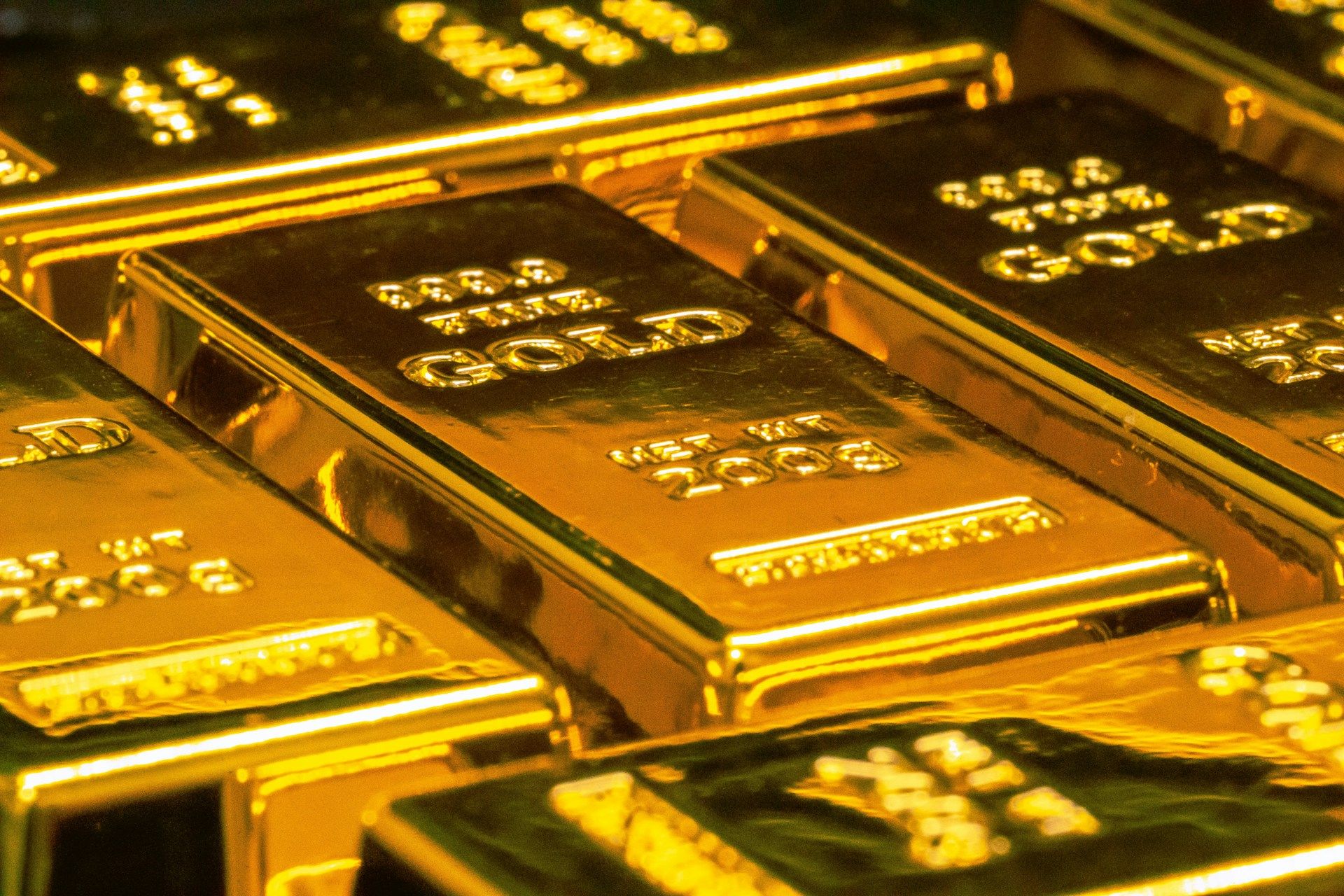 replacement. The Morgan Stanley chief investment officer recently recommended a 60/20/20 portfolio that includes 20% gold is a more resilient hedge.
replacement. The Morgan Stanley chief investment officer recently recommended a 60/20/20 portfolio that includes 20% gold is a more resilient hedge.
Major Wall Street Icons Urging Americans to Increase Gold Allocation
It’s not just Morgan Stanley. Billionaire Ray Dalio and founder of Bridgewater, one of the world’s largest hedge funds, recommends that everyday investors allocate as much as 15% of their portfolios to gold. Jeffrey Gundlach, known as Wall Street’s “Bond King” notably pointed to gold as his top investment idea today and said that investors allocating as much as 25% of their portfolios was “not excessive.” These are just a few of the major Wall Street icons urging investors to add more gold to their portfolios in 2025.
The 60/40 Stock/Bond Portfolio Can’t Protect Your Wealth as National Debt Balloons
The reason? The 60/40 portfolio is letting investors down. You may remember the dismal double-digit losses for both stocks and bonds in 2022. The 60/40 portfolio did not provide investors with any protection from a stock market crash.
Bottom line? A portfolio of stocks and bonds is no longer sufficient to protect and grow your assets in today’s changing climate.
Government debt numbers are climbing, not falling, leading J.P. Morgan’s chief global strategist David Kelly to put it bluntly: America is “going broke.” The U.S. currently owes more than $37.8 trillion with interest on the debt topping $1.2 trillion.
So, the U.S. is creating more paper money and printing more debt, and when a government floods the system with paper money, gold increases in value, while the paper money falls in value. That’s exactly what we are seeing today. The U.S. dollar is down; gold is up big.
The takeaway for investors?
Today is the time to make portfolio moves. Kelly said: “There is a danger that political choices lead to a faster deterioration in the federal finances, leading to a backup in long-term interest rates and a lower dollar. Based on current allocations and valuations alone, many investors should likely consider diversifying their portfolios by adding alternative assets and international stocks. The risk that we move from
going broke slowly to going broke quickly adds an important reason to make this move today.”
The Global Shift Away from the U.S. Dollar Impacts Treasuries
What’s more the bond market simply isn’t working as a hedge against stocks like it used to. One reason is that there isn’t as much global demand for U.S. dollar denominated assets like there used to be. Global central banks used to be major buyers of U.S. Treasuries as they put their dollar reserves into U.S. debt. The U.S. dollar’s role, however, has become less central to the global economy.
Over the past 11 years, central banks have stopped adding to their foreign exchange reserves. The U.S. dollar’s share of central bank global reserves, while still big, has shrunk to 58% from two-thirds a decade ago. Notably, in this same period, global central banks have been major buyers of gold.
More Inflation Ahead?
Inflation has yet to be vanquished and with concerns about the Federal Reserve retaining independence, there are rising worries that inflation could rise not fall in the years ahead. Notably, the 60/40 portfolio performed dismally during the 1970’s Great Inflation period.
From 1973-1974, the 60/40 portfolio delivered -11.95% return. Gold, meanwhile, surged 69% in that period, according to Morningstar Direct.
Getting Started
As you look to rebalance your portfolio, consider decreasing your exposure to bonds (which have largely been a losing asset) and increase your exposure to gold. The 60/20/20 stock/bond/gold portfolio is already becoming the new normal, and this gold rally has farther to go. Goldman Sachs recently upgraded it’s 2026 gold forecast to $4,900 an ounce. Societe Generale recently wrote in a research note that “Gold’s ascent to $5000 seems increasingly inevitable.” Bank of America recently hiked its 2026 forecast for gold to $5,000. If you buy gold today, and the precious metal climbs to $5,000 next year, you’d lock in a 21% gain from current levels.
Gold offers a proven hedge against inflation, paper currency devaluation, and geopolitical risks that can disrupt other asset classes. If you act today, you not only will protect your wealth but also position yourself to benefit from more upside in the gold rally ahead. Don’t wait for stock market conditions to worsen—seize the opportunity today to enhance your portfolio’s resilience and secure long-term growth with an increased allocation to gold.
Storage and Care Tips for Your 1-Kilo Silver Bar: Complete Guide
Posted on — Leave a commentOne improperly stored 1-kilo silver bar can lose hundreds in resale value from tarnish alone. Unlike gold, silver is highly reactive and vulnerable to humidity, sulfur, and temperature shifts. Once tarnished, the damage is permanent: buyers discount heavily, and liquidity suffers. The good news, however, is that preventing this is simple. With the right storage, handling, and environmental controls, investors can keep their silver in investment-grade condition. This guide explains why silver demands unique care, giving you the exact steps to preserve the value, appearance, and marketability of your 1-kilo bars.
What Is a 1-Kilo Silver Bar
A 1-kilo silver bar is a global benchmark for serious silver investors, combining cost efficiency, purity, and manageable size.
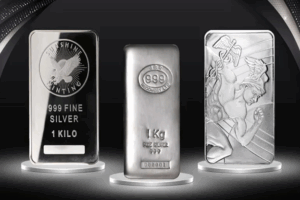
Image: Different examples of 1-kilo silver bars, showing variations in design and finish.
Source: Rethinking The Future
Metric Standard
The 1,000-gram format gained prominence in the late 20th century as international silver trading expanded beyond traditional imperial systems. European and Asian refineries led this shift, finding metric measurements simplified cross-border transactions and inventory management. Today, major exchanges and dealers recognize a 1-kilo bar of silver as a standard investment unit, making these bars highly liquid in global markets.
Ounce Conversion
Each 1-kilo bar of silver contains exactly 32.15 troy ounces of silver. This matters particularly for American investors accustomed to thinking in ounces: a 1-kilo bar equals roughly 32 American Silver Eagles or three 10-ounce bars. This conversion knowledge helps when comparing premiums across different product sizes and calculating portfolio allocations.
Purity Specifications
While .999 fine silver (99.9% purity) has become the accepted minimum for investment-grade bars, some older or industrial bars may contain .925 or .950 silver. Investment-grade purity ensures immediate recognition by dealers and maintains consistent melt values across different manufacturers.
Investment Positioning
The 1-kilo bar of silver format targets serious investors seeking lower premiums without institutional-level commitments. These bars offer significantly better pricing than smaller denominations while avoiding the storage challenges of massive commercial bars. Unlike 100-ounce bars that demand specialized vaults, 1-kilo bars fit standard home safes and remain light enough for personal handling and transport.
Watch this visual guide to silver bar stacking to see how 1 kilo bars fit into a broader precious metals strategy.
1-Kilo Silver Bar Physical Specifications
A 1-kilo silver bar weighs 2.2 pounds and typically measures roughly the size of a large smartphone, but significantly thicker and denser.
Exact Measurements
Typical dimensions are around 114mm × 57mm × 13mm (4.5″ × 2.25″ × 0.5″), though 1-kilo silver bar size varies slightly by manufacturer. Minted bars are more uniform, while cast bars may be chunkier or irregular. These compact dimensions make kilo bars stackable in most home safes and easy to handle with one hand.
Weight Precision
Most investment-grade kilo bars fall within ±1-2 grams of the stated 1,000 g weight. This precision when it comes to 1-kilo silver bar weight ensures accurate precious metals calculations and meets exchange standards for trading and storage facility acceptance.
Surface Characteristics
Silver bars come in two main finishes: cast and minted (also called pressed). Cast bars are poured into molds, creating rougher, textured surfaces that hide minor scratches but show fingerprints easily. Pressed bars undergo additional machining for mirror-like finishes that display scratches prominently but their smooth surfaces leave fewer crevices where tarnish and contaminants can settle, helping them maintain a cleaner appearance over time.
Silver Density
Silver’s lower density (10.49 g/cm³) compared to gold (19.32 g/cm³) means 1-kilo silver bars appear significantly larger than equivalent-weight gold bars, requiring more storage space and different stacking considerations for vault organization.
Major 1-Kilo Silver Bar Manufacturers
Not all 1-kilo silver bars offer equal liquidity or recognition. Manufacturer reputation directly affects resale ease and buyer confidence. Learn more about purchasing investment-grade bars from reputable refineries.
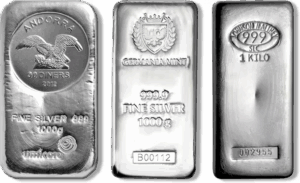
Image: Examples of 1-kilo silver bars from Umicore, Germania Mint, and Johnson Matthey.
Source: Blanchard
Johnson Matthey Leadership
Johnson Matthey, refining precious metals since 1817, built unmatched credibility in global markets. In 2015, the company sold its bullion division to Asahi Refining, but existing Johnson Matthey 1-kilo silver bar bullion remains highly liquid. With distinctive serial numbering and security elements that make counterfeiting difficult, these bars continue to command premiums worldwide. Dealers instantly recognize their quality standards and trust their resale value. Johnson Matthey held LBMA Good Delivery accreditation, ensuring its bars met the strictest standards for weight, purity, and appearance.
Germania Mint
Germania Mint, established in 2018 by Poland’s Kurowski Group, combines traditional European craftsmanship with modern production techniques. Germania mint 1-kilo silver bar bullion features the distinctive Germania figure, symbolizing the historic central European region, along with detailed design elements that set them apart from generic bullion. Struck to .9999 purity, these bars reflect consistent quality and modern finishing standards. Though relatively new, Germania has gained rapid acceptance among collectors and investors, particularly in European markets where its cultural imagery resonates strongly.
Umicore
This Belgian refining giant brings industrial-scale precision to precious metals production. Umicore’s 1-kilo silver bars feature clean, professional designs with advanced security elements including unique serial numbering and secure packaging options depending on size. The company’s extensive experience in metals processing ensures consistent quality and purity standards. Umicore bars have established strong recognition among European dealers and are increasingly accepted in international precious metals markets.
Other Notable Refineries
The refiners highlighted above are only part of the global bullion landscape. Across Europe and beyond, several LBMA-accredited refiners produce 1-kilo silver bars that enjoy strong dealer recognition and investor trust. PAMP Suisse, with its Fortuna design and Veriscan technology, and Metalor, known for its century of refining heritage and clean, consistent bar designs, are two leading examples. Others, such as Valcambi, Heraeus, and Argor-Heraeus, likewise uphold the highest standards of weight, purity, and security, ensuring their kilo bars remain highly liquid across international markets.
Storage Requirements and Environmental Factors
Silver’s reactive chemistry makes environmental control the most critical factor in preserving your 1-kilo silver bar value and condition. Learn more about comprehensive storage strategies for precious metals.
Tarnishing Prevention
Humidity above 50% accelerates tarnish by helping sulfur compounds bond with silver. Everyday sources, like heating systems, cleaning agents, rubber, wool, or cigarette smoke, release these particles into the air. Combined with moisture, they form silver sulfide, leaving permanent black spots. Maintaining low humidity and clean air prevents these reactions and preserves silver’s appearance.
Temperature Control
Consistent temperatures between 60-70°F work best for silver storage. Fluctuations create condensation, which leads to spotting and tarnish, and can also stress protective packaging over time. Basements and attics with wide swings in heat or cold pose particular risks to long-term preservation.
Container Selection
Airtight containers prevent airborne contaminants from reaching silver surfaces but can trap moisture if not properly prepared. Breathable storage allows air circulation but offers less protection from environmental pollutants. The choice depends on your specific storage environment and climate control capabilities.
Stacking Methods
How silver bars are stacked directly impacts their condition over time. Placing bars in direct metal-to-metal contact can cause scratches, surface wear, and pressure marks. Using protective separators, such as soft cloth, mylar sheets, or original packaging, prevents this damage while still allowing efficient use of storage space.
Physical Handling and Care Techniques
Proper handling prevents the scratches, fingerprints, and drops that permanently damage 1-kilo silver bars and reduce their resale value.
Proper Lifting
Always use both hands when lifting 2.2-pound bars to maintain control and prevent dropping. A 1-kilo silver bar in ounces weighs 32.15 troy ounces, making proper support essential to prevent accidents. Support the bar from underneath rather than gripping the edges, which can leave pressure marks. Move slowly and deliberately.
Glove Requirements
Cotton gloves are essential when examining bars for extended periods or handling multiple pieces. For quick inspections or single movements, clean, dry hands work fine but any skin contact still risks fingerprints. Avoid latex or rubber gloves, which contain sulfur compounds that can cause tarnishing. Similar protective measures are essential when handling silver coins as well.
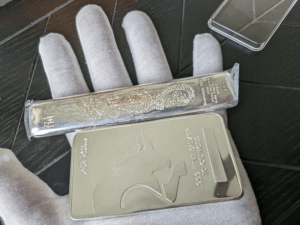
Image: Silver bars being handled with protective cotton gloves to prevent scratches and fingerprints.
Source: Reddit
Surface Protection
Skin oils and fingerprints create permanent spots on silver surfaces. Even brief contact leaves residue that attracts contaminants and accelerates tarnishing. Handle bars by their edges when possible, avoiding contact with flat surfaces.
Inspection Procedures
Check bars in good lighting without touching surfaces unnecessarily. Look for new scratches, spots, or discoloration. Rotate bars gently to examine all surfaces, using cotton gloves if extended handling is required.
Cleaning Protocols
Never clean investment-grade silver bars unless absolutely necessary. Cleaning removes microscopic amounts of silver and can create micro-scratches. If cleaning becomes unavoidable, use only distilled water and soft cloths, avoiding all chemical cleaners.
Home Storage Solutions vs. Professional Storage Options
The choice between home and professional storage depends on your security needs, access requirements, and insurance considerations. Before purchasing any 1-kilo silver bar for sale, consider your storage strategy to ensure proper preservation of your investment.
Home Storage Solutions
Safe Specifications
A quality fire-resistant safe rated for at least 1 hour at 1200°F can protect multiple 1-kilo bars. Look for safes with interior dimensions accommodating stacked bars with protective separators.
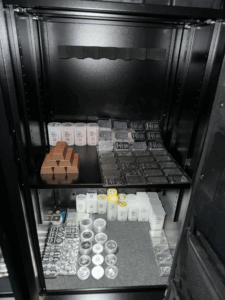
Image: Organized silver bars and coins stored securely inside a home safe.
Source: Reddit
Humidity Control
Basement storage requires dehumidifiers maintaining sub-50% humidity levels. Desiccant packets inside storage containers provide additional moisture protection, especially in garages subject to temperature swings. Replace or recharge desiccants regularly, since they lose effectiveness.
Organization Systems
Create inventory logs tracking each bar’s condition and location. Use protective sleeves or separators to access specific bars without handling others unnecessarily.
Security Considerations
Avoid obvious locations like master bedrooms. Consider multiple smaller safes rather than one large unit to spread risk and avoid drawing attention.
Professional Storage Options
Bank Safe Deposit Boxes
Most boxes accommodate 2-4 kilo bars comfortably, though not all banks permit bullion storage – check policies before renting. Access requires bank hours and dual-key procedures, limiting flexibility but providing institutional security.
Precious Metals Depositories
Segregated storage keeps your specific bars separate, while allocated storage pools bars with guaranteed quantities. Segregated costs more but ensures you receive your exact bars back.
Insurance Coverage
Professional storage typically includes comprehensive coverage, while home storage may require additional riders on homeowner’s policies.
Access Procedures
Professional facilities offer appointment-based access with detailed withdrawal procedures and identity verification requirements.
Common Storage Mistakes and Solutions
Even experienced investors can make storage errors that permanently damage their silver bars and reduce resale values. Proper care becomes essential when you understand why tangible assets play such an important role in wealth preservation. Here’s how to avoid the most common mistakes.
Moisture Exposure
Humidity above 50% creates irreversible tarnishing and black spotting on silver surfaces. Once these chemical reactions occur, the damage cannot be undone without removing silver material. Ideal storage maintains 30-40% relative humidity to prevent these chemical reactions entirely. Use dehumidifiers and moisture-absorbing packets to maintain dry storage environments.
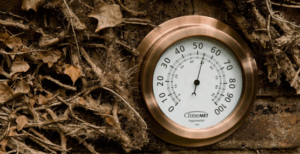
Image: Hygrometer measuring humidity levels, essential for silver storage environments.
Source: ClimeMET
Chemical Contamination
PVC plastics, rubber materials, and acidic papers release sulfur compounds that cause permanent discoloration. Avoid wrapping bars in plastic film, storing them on rubber mats, or keeping them in ordinary cardboard boxes. Instead, use archival-quality containers and inert materials designed for precious metals storage.
Temperature Fluctuations
Stable ~65°F storage is safer than perfect temperature targets with big swings. Fluctuations cause condensation that stresses packaging and promotes tarnish.
Overcrowding
Bars stacked without separators scratch each other during handling and settling. Allow space between pieces and use protective barriers to prevent metal-to-metal contact during storage and access.
Documentation Errors
Maintain detailed records including purchase dates, conditions, and photographs. For each 1-kilo .999 silver bar in your collection, document purity specifications and serial numbers for insurance and resale purposes. Insurance claims require proof of ownership and condition, while accurate documentation speeds resale transactions and establishes authenticity.
Long-Term Preservation Tips and Strategies
Successful long-term silver storage requires systematic monitoring and proactive maintenance to preserve investment value over decades.
Monitoring Schedules
Inspect stored bars every 6-12 months for new tarnishing, scratches, or environmental damage. More frequent checks risk unnecessary handling, while longer intervals allow problems to worsen undetected.
Condition Documentation
Photograph each bar from multiple angles when first stored, documenting serial numbers and any unique characteristics. Update records during regular inspections to track any changes in condition. These detailed records prove original condition for insurance claims and help establish authenticity during resale transactions, while serial number documentation prevents disputes over specific bar identity.
Preventive Maintenance
Address minor tarnishing immediately by improving storage conditions rather than cleaning bars. Identify and eliminate sulfur sources, adjust humidity levels, and upgrade protective materials before damage spreads.
Storage Upgrades
Invest in better storage solutions when collections grow beyond current capacity or when environmental controls prove inadequate. Quality storage pays for itself through preserved condition and resale values.
Estate Planning
Document storage locations, access procedures, and handling requirements for heirs. Include inventory lists, authentication details, and dealer contacts to ensure smooth transitions while maintaining proper care standards.
Conclusion
Proper storage transforms 1-kilo silver bars from vulnerable investments into preserved assets. Environmental control prevents irreversible tarnishing, careful handling maintains pristine surfaces, and systematic documentation protects insurance coverage and resale value.
For serious precious metals investors, 1 kilo bars offer an ideal balance of storage efficiency and manageable ownership. Their substantial size reduces per-ounce premiums while remaining practical for individual handling and home storage solutions.
Ready to buy 1-kilo silver bar bullion? Explore Blanchard’s selection of 1-kilo silver bars from trusted refineries like Johnson Matthey, Germania Mint, and other respected manufacturers.
FAQs
1. How much is a 1-kilo silver bar worth?
1-kilo silver bar price depends on current silver spot prices plus a modest premium over the raw metal value. The exact worth changes daily with precious metals markets, but kilo bars generally offer better value per ounce than smaller silver products.
2. How many ounces in 1-kilo silver bar bullion?
Each 1-kilo bar contains exactly 32.15 troy ounces of silver.
3. How big is a 1-kilo silver bar?
A 1-kilo bar measures approximately 4.5 inches long, 2.25 inches wide, and half an inch thick – roughly smartphone-sized but significantly heavier and denser.
4. How to store a 1-kilo silver bar safely?
Effective silver storage means controlling the environment and using the right materials. Keep humidity below 50%, maintain consistent temperatures, and avoid PVC or other sulfur-emitting plastics. Store bars with protective separators in a quality safe or consider professional facilities that provide stable, insured conditions.
Silver Performance During Recessions
Posted on — Leave a commentDuring economic uncertainty, investors often flock to precious metals. These assets tend to hold their value when others fall and can help guard against inflation. Unlike paper currencies, they offer tangible worth that can’t be eroded by government policies. Among them, silver stands out thanks to its dual nature. It functions as an industrial metal essential in electronics, solar panels, and medical applications while serving as an investment asset. This article analyzes silver’s historical performance during major downturns, examining silver price during recession periods compared to other investments and whether it deserves consideration as a portfolio stabilizer during turbulent economic times.
Looking for more insights on how silver behaves during economic downturns? This informative analysis breaks down silver’s historical performance during various recession periods: https://www.youtube.com/watch?v=z5wDHuSgooU
Silver’s Historical Performance During Major Recessions
Over the past 50 years, silver’s performance during recessions has followed clear patterns. Although each downturn is different, silver has shown both weakness and resilience depending on the nature of the recession, monetary policy responses, and overall market sentiment. This section looks at four major recessions to shed light on the question “How does silver perform in a recession?”.
The 1970s Recession and Silver’s Price Movement
The stagflation of the 1970s, characterized by high inflation and stagnant economic growth, created ideal conditions for the silver market recession response. Silver prices surged from under $2 per ounce in early 1970 to nearly $50 by January 1980, delivering one of the most dramatic bull runs in its history. During this decade, silver vastly outperformed traditional assets. While the S&P 500 struggled with inflation-adjusted losses and bond yields were eroded by rising prices, silver delivered exponential gains. Though gold drew more headlines, silver outpaced it in percentage terms, highlighting its role as a high-performing inflation hedge.
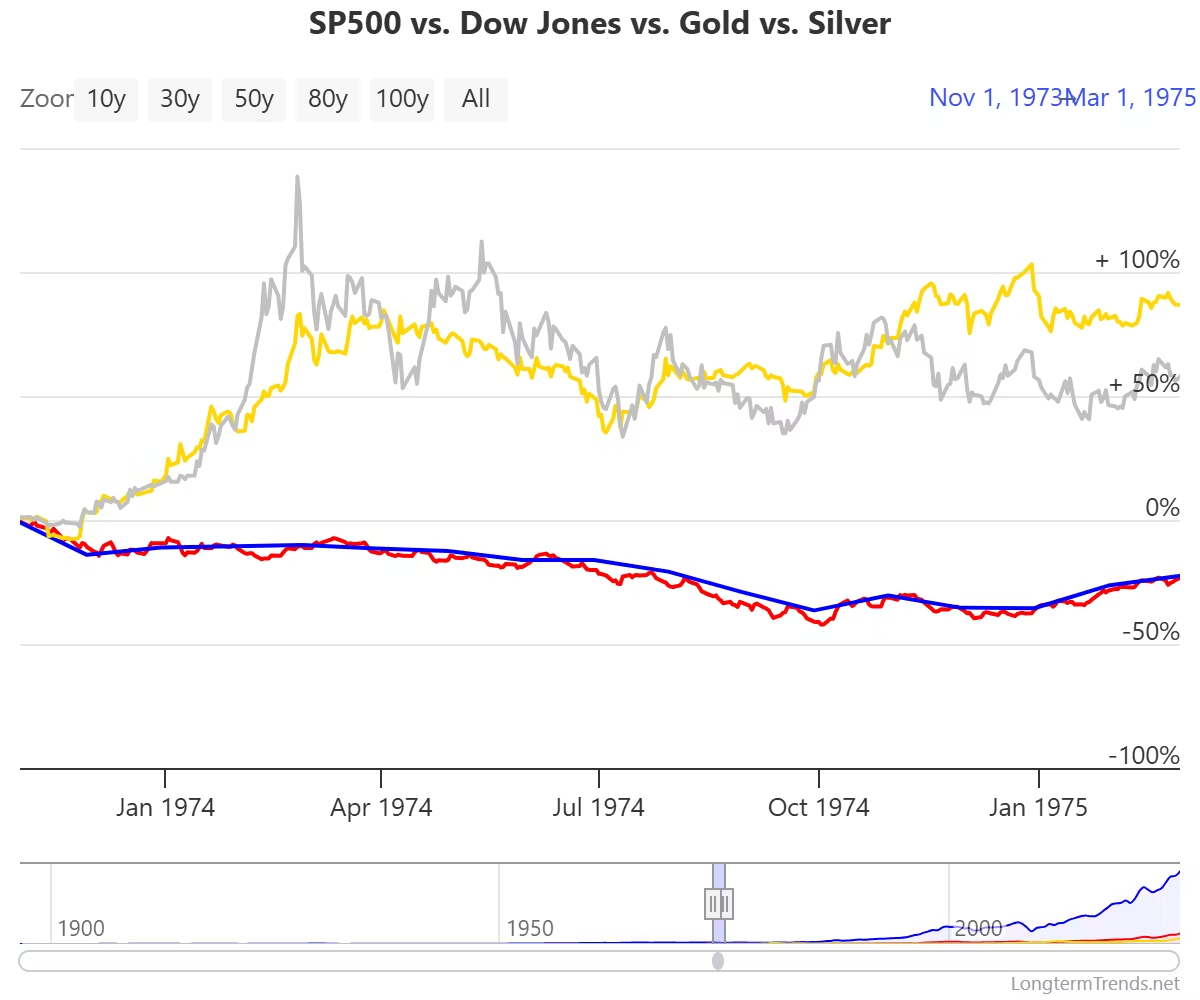
Chart: S&P500 vs. Dow Jones vs. Gold vs. Silver (1973-1975). Source: Data from LongTermTrends.net.
Silver During the 1981 Recession
The 1981-1982 recession tells a different story for silver markets. According to data from Visual Capitalist, silver underperformed compared to both gold and equities during this contraction. Silver prices fell from approximately $16 to $8 per ounce through this period. This was influenced by two key factors. Firstly, the Federal Reserve’s aggressive interest rate hikes to combat inflation played a significant role, driving up the value of the U.S. dollar and making precious metals less attractive. Secondly, silver faced pressure from weak industrial demand as economic activity slowed, alongside reduced investor interest in commodities.
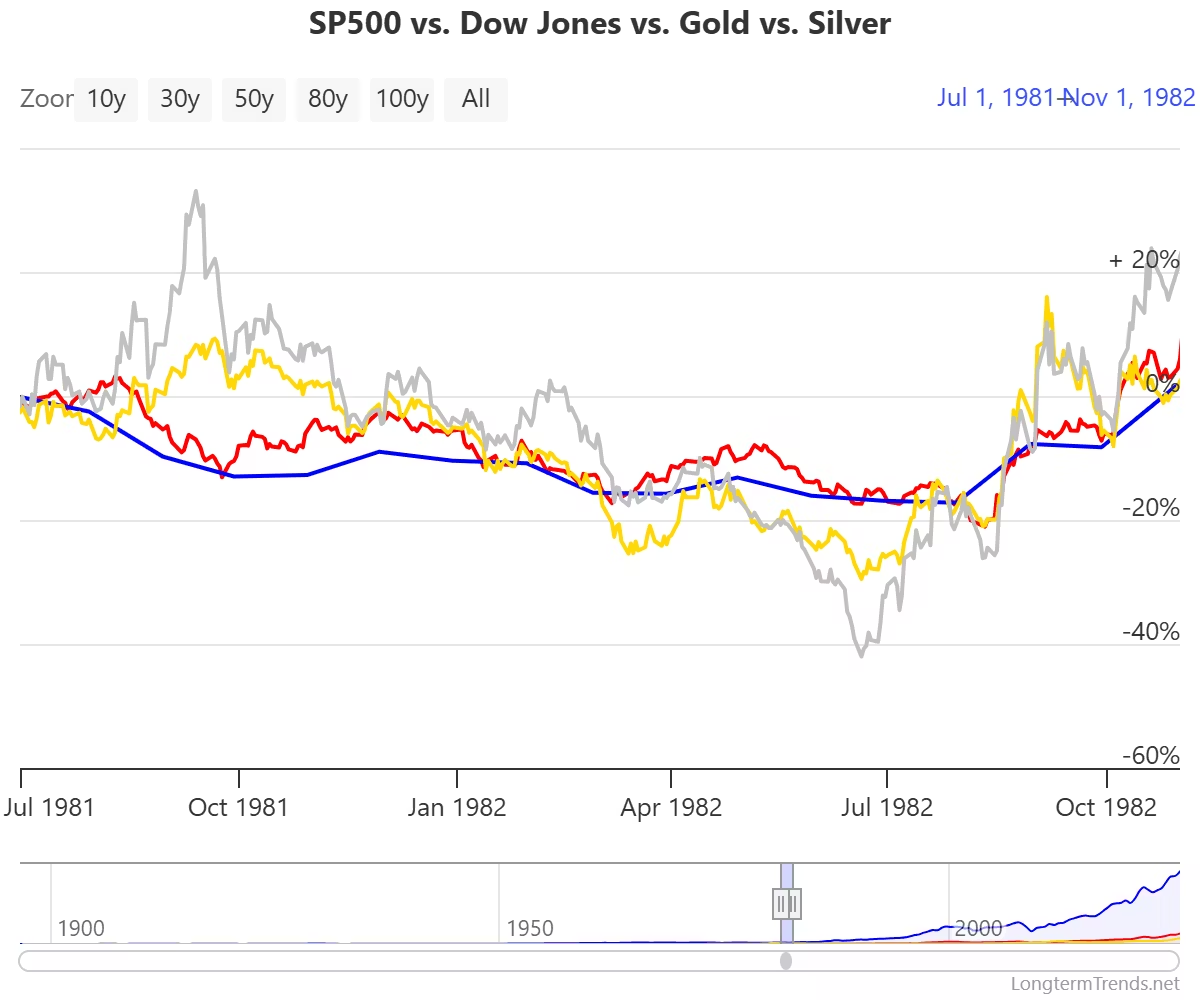
Chart: S&P500 vs. Dow Jones vs. Gold vs. Silver (1981-1982). Source: Data from LongTermTrends.net.
COVID-19 Economic Contraction and Silver Prices
The COVID-19 pandemic created extreme volatility in silver markets. This recent case study illustrates what happens to silver prices during a recession characterized by global pandemic conditions and unprecedented monetary intervention. Initially, silver plummeted alongside equities, falling nearly 40% in March 2020 to below $12 per ounce as market liquidity evaporated. This initial reaction highlighted how silver can sometimes behave like risk assets during panic phases. However, silver’s recovery was remarkable, more than doubling from its lows within five months to over $28 per ounce by August 2020. This performance was driven by a combination of monetary stimulus, supply disruptions from mine closures, industrial demand recovery, and investor interest in hard assets. The COVID recession reinforced the pattern that while silver may not provide immediate recession protection, it often delivers strong performance during the recovery phase.
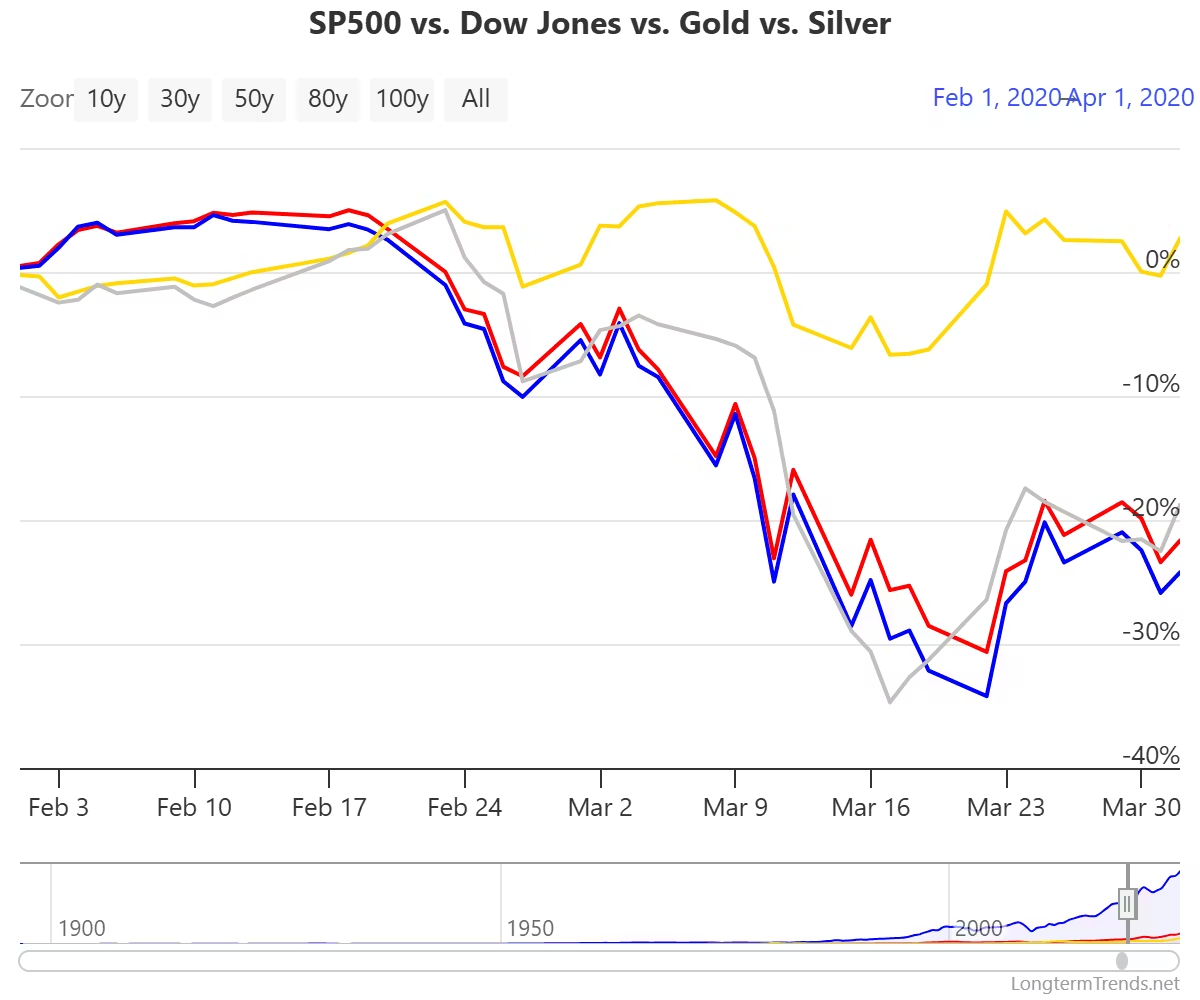
Chart: S&P500 vs. Dow Jones vs. Gold vs. Silver (Feb-Apr 2020). Source: Data from LongTermTrends.net.
Comparing Silver vs. Stocks During Recessions
Understanding how silver performs relative to equities during economic downturns can help investors optimize their portfolio allocations when recession signals appear. Blanchard’s Silver vs. Stocks: Comparing Performance During Recessions provides further valuable insights into this relationship through historical analysis.
Statistical Analysis: Silver vs. S&P 500
According to data highlighted by Visual Capitalist, silver vs stocks during recession analysis shows silver outperformed the S&P 500 in three of the last eight U.S. recessions. These periods were marked by economic instability, inflationary pressure, or financial crises, which tend to favor hard assets over equities. During the 1973-75 recession, silver surged due to inflation and geopolitical tensions, while the stock market experienced significant declines. Similarly, in the 1981 recession and the 2007-09 financial crisis, silver preserved or gained value as equities struggled. This pattern suggests that silver tends to excel in downturns driven by inflation, policy shifts, or market uncertainty.

Chart: How Silver Performs During Recessions by Elements, Visual Capitalist (2022). Data sourced from Macrotrends and MarketsWiki.
When Silver Outperforms Equities
Silver typically outperforms stocks under three conditions: during high inflation and currency devaluation, during financial system stress, and following aggressive monetary stimulus. In 1973-75, silver rose sharply as inflation surged and confidence in traditional markets weakened. In 1981, although the Fed’s rate hikes later suppressed silver, it initially held strong due to inflation fears. During the 2007-09 crisis, silver acted as a safe-haven asset amid collapsing financial institutions and aggressive monetary stimulus. These case studies show that silver thrives when fiat currency value is in question or when investors seek a hedge against systemic risk – conditions under which equities typically underperform.

Chart: Silver vs. S&P 500
When Stocks Outperform Silver
Stocks tend to outperform silver during recession recovery phases marked by economic stabilization, rising consumer confidence, and strong corporate earnings. In such periods, investors shift from safe-haven assets like silver to risk assets like equities, anticipating growth and profitability. Silver underperforms when inflation is low or falling, interest rates are stable or rising, and industrial demand is weak. For example, during the mid-1990s recovery and the post-2001 recession period, silver lagged behind the S&P 500 as tech and financial sectors led the market rebound. These environments favor equity gains over precious metals, which lose appeal as fear and uncertainty fade.
What Happens to Silver Prices During a Recession?
While no two recessions impact silver identically, its prices follow distinctive patterns during economic downturns that reflect competing forces of supply, demand, and investor sentiment.
Initial Market Reaction and Price Volatility
In the early stages of a recession, silver prices often experience heightened volatility due to shifting investor sentiment and liquidity pressures. Initially, silver may drop as investors sell off assets to raise cash and cover losses elsewhere. This pattern was evident in 2008 when silver dropped from $21 to $16 per ounce and in March 2020 when prices plummeted nearly 40%. This liquidity-driven dip is common during sudden market stress, creating short-term pressure regardless of fundamental outlook.
Industrial Demand Impact
Silver is a key industrial material, with over 50% of its demand tied to manufacturing sectors such as electronics, solar energy, and medical devices. During recessions, when industrial production slows, this demand often contracts, putting downward pressure on silver prices. The electronics sector, which accounts for nearly 25% of industrial silver usage, often sees reduced output during recessions. Similarly, automotive industry slowdowns affect silver demand for electrical components.
Investment Demand as Safe-Haven Asset
Counterbalancing industrial weakness, investment demand for silver often increases during prolonged periods of market stress and economic uncertainty, influencing silver vs stocks during recession performance patterns. Investors typically turn to physical silver as a store of value, especially when inflation rises or confidence in financial markets declines. This is reflected in increased purchases from both retail and institutional buyers. Additionally, silver-backed ETFs often experience notable inflows during recessions, signaling heightened investor interest. For example, during the 2008 financial crisis and the COVID-19 recession, silver ETFs saw significant growth, with the iShares Silver Trust seeing inflows of over $500 million in April 2020 alone.
Is Silver Just as Good as Gold in a Recession?
While both metals serve as portfolio hedges during economic uncertainty, silver and gold behave quite differently in recessions, each offering distinct advantages and drawbacks for investors seeking protection.
Comparing Silver and Gold Performance
Historical data shows gold typically outperforms silver during recession initial phases. In the 2008 crisis, gold declined just 12% from peak to trough, while silver plummeted over 50%, making gold options like Blanchard Gold Products particularly attractive during early recession phases. However, silver often delivers stronger returns during recovery phases. After 2008, silver surged 400% from its lows versus gold’s 170%. The gold-to-silver ratio typically spikes during recessions, reaching 114:1 in March 2020 compared to its historical average of 60:1, often contracting during recoveries and creating potential opportunities. Blanchard’s Measuring the Impact of Silver versus Gold in Your Portfolio explores how these dynamics can influence optimal allocation between both metals.

Chart: Historical Gold and Silver Prices (1992-2020). Data from London Bullion Market Association (LBMA).
Silver’s Higher Volatility
Silver consistently demonstrates greater volatility than gold, with sharper price swings during both downturns and recoveries. During the 2020 COVID-19 disruption, silver dropped 40% compared to gold’s 15% decline but subsequently gained 140% versus gold’s 40% rise. This volatility stems from silver’s smaller market size (roughly one-tenth of gold’s), making it more susceptible to liquidity pressures. While gold typically offers a steadier, lower-risk profile, silver presents a higher risk-reward proposition. As such, silver tends to be more appealing to investors who can withstand short-term turbulence in pursuit of long-term upside.
Industrial vs. Monetary Demand
A key distinction between silver and gold lies in their demand sources. Silver derives a significant portion of its value from industrial use, making it more sensitive to economic slowdowns. In contrast, gold’s primary role as a monetary asset creates more consistent recession demand, with approximately 85% of annual demand from investment and central banks. Gold responds more directly to interest rates and currency concerns, while silver adds exposure to industrial recovery. This makes silver less reliable during recession depths but potentially more rewarding during recovery transitions.
Is Silver a Good Investment During a Recession?
While not a perfect safe haven, silver offers unique characteristics that may benefit portfolios positioned for both protection and recovery potential. This section examines the key considerations that can help investors decide if silver belongs in their recession strategy.
Silver’s Pros During Economic Downturns
When considering silver’s advantages during economic contractions, several factors stand out. First, silver provides effective inflation protection when central banks implement stimulus measures. Since silver cannot be created through monetary policy like currencies, it often preserves purchasing power when money supply expands. Second, silver serves as a portfolio diversifier, typically showing low correlation with traditional assets during market stress periods. Third, silver offers exceptional recovery potential. Following the 2008 crisis, prices rose over 400% from their lows as economic conditions improved while stimulus remained in place.
Potential Drawbacks to Consider
Despite its benefits, silver comes with some limitations during recessions, too. First, silver’s industrial demand component creates vulnerability when manufacturing activity declines, as roughly half of silver consumption comes from industrial applications. Second, silver exhibits substantially higher volatility than gold, with price swings often 2-3 times more severe in both directions, requiring greater investor conviction. Third, practical challenges exist. Physical silver requires considerable storage space due to its lower value density compared to gold.
How to Invest in Silver for Recession Protection
There are several ways for investors to access silver’s recession protection, each suited to different investment strategies and risk preferences.
Physical Silver Options
Investors looking for direct exposure to silver during a recession often turn to physical silver, such as coins and bars from reputable dealers like Blanchard Silver Products. These tangible assets offer a secure store of value, high liquidity, and recognition. However, premiums on physical silver can increase during market stress due to higher demand and supply chain disruptions. The cost of acquiring silver in its physical form during a recession period often exceeds the spot price, with premiums varying based on the type of silver, mint, and market conditions. Notably, during the March 2020 silver market recession, Silver Eagle premiums temporarily exceeded 100% over spot prices as retail demand surged while supply chains faced disruption.
Paper Silver Investments
Paper silver investments, such as silver-backed ETFs and mining stocks, offer a more liquid and accessible way to gain exposure to silver. ETFs track silver’s price without requiring physical storage, making them a convenient option. Mining stocks provide indirect exposure, benefiting from rising silver prices while offering additional growth potential through company performance. However, paper silver does not provide direct metal ownership and comes with its own set of risks, including tracking errors in ETFs and the volatility of mining stocks. Unlike physical silver, paper investments are subject to market fluctuations and can be impacted by factors beyond the price of silver itself, such as company management and geopolitical risks.
Timing and Allocation Strategies
When investing in silver, it’s important to carefully consider the appropriate portfolio allocation, particularly during periods of economic uncertainty. Typically, financial advisors suggest allocating 5-10% of a diversified portfolio to precious metals like silver, though this can vary depending on an investor’s risk tolerance and market outlook. Some investors also consider numismatic options, as outlined in the Blanchard Rare Coins Guide, for additional portfolio diversification. For timing, a dollar-cost averaging (DCA) approach is often recommended. This strategy involves spreading purchases over time to reduce the impact of short-term price fluctuations, allowing investors to avoid making large commitments during market peaks.
Conclusion
Silver offers investors a compelling option during economic downturns, with historical performance showing a distinctive pattern across multiple recessions. When analyzing the question “How does silver perform in a recession?”, we see that while it typically faces initial pressure, it often delivers substantial returns during recovery phases. This behavior stems from silver’s unique dual role in the global economy, functioning simultaneously as an industrial commodity and a precious metal investment.
As a portfolio component during uncertain times, silver provides diversification benefits that differ from both traditional assets and gold. Its ability to hedge against inflation while maintaining low correlation to equities creates defensive characteristics, while its essential role in manufacturing and technology gives investors exposure to eventual economic recovery that purely monetary metals cannot offer. However, investors should approach silver with appropriate allocation strategies. Its higher volatility requires greater conviction than gold, and its industrial demand component creates some vulnerability during manufacturing slowdowns.
For those with suitable risk tolerance, silver represents not just a recession hedge but a potentially high-performing asset that can fulfill both protective and growth-oriented roles when strategically positioned within a diversified portfolio.
FAQ Section
1. How does silver perform in a recession?
Silver typically follows a distinct pattern during recessions: initial decline during market panic, followed by strong recovery when stimulus measures are implemented. It has outperformed the S&P 500 in three major recessions (1973, 1981, 2007), with performance driven by inflation rates, monetary policy responses, industrial demand fluctuations, and investor sentiment toward safe-haven assets during financial uncertainty.
2. Is silver just as good as gold in a recession?
Silver offers different recession benefits than gold, not necessarily better or worse. While gold typically provides more stability during market turmoil (falling less during the 2008 crisis), silver tends to deliver stronger recovery performance (surging 400% after 2008 versus gold’s 170%). Silver’s higher volatility stems from its smaller market size and dual industrial-investment nature, creating greater downside risk during recession onset but potentially larger upside during economic recoveries when industrial demand returns.
3. What happens to silver prices during a recession?
During a recession, silver prices typically follow a two-phase pattern. In the initial recession stage, silver often experiences significant selling pressure as investors liquidate positions to raise cash, causing prices to decline alongside risk assets. As the recession progresses and central banks implement accommodative monetary policies, silver prices tend to recover and potentially appreciate substantially, particularly when inflation concerns emerge or industrial demand begins to rebound while stimulus measures remain in place.
4. Is silver a good investment during a recession?
Silver offers both advantages and risks during recessions. On the positive side, it acts as a hedge against inflation and currency devaluation that often follow stimulus measures while providing portfolio diversification with recovery potential (rising over 400% after the 2008 crisis). However, silver also faces challenges during economic contractions since roughly half its demand comes from industrial applications, making it vulnerable to manufacturing slowdowns.
5. How does silver compare to stocks during recessions?
Silver has outperformed the S&P 500 in three of the last eight recessions since the 1970s. Silver tends to excel over stocks when specific economic conditions emerge: high or rising inflation that erodes equity valuations, significant currency devaluation concerns following aggressive monetary stimulus, and periods of financial system stress where confidence in traditional markets falters. However, stocks typically outperform silver during disinflationary recessions and in recovery phases characterized by strong growth without significant inflation pressures.
Photos:

Image: Solar panel array.
Image credit: The Silver Institute

Silver Britannia coin. Photo: Osama Madlom/Unsplash








